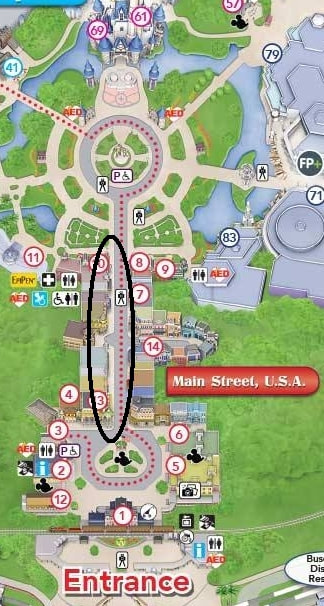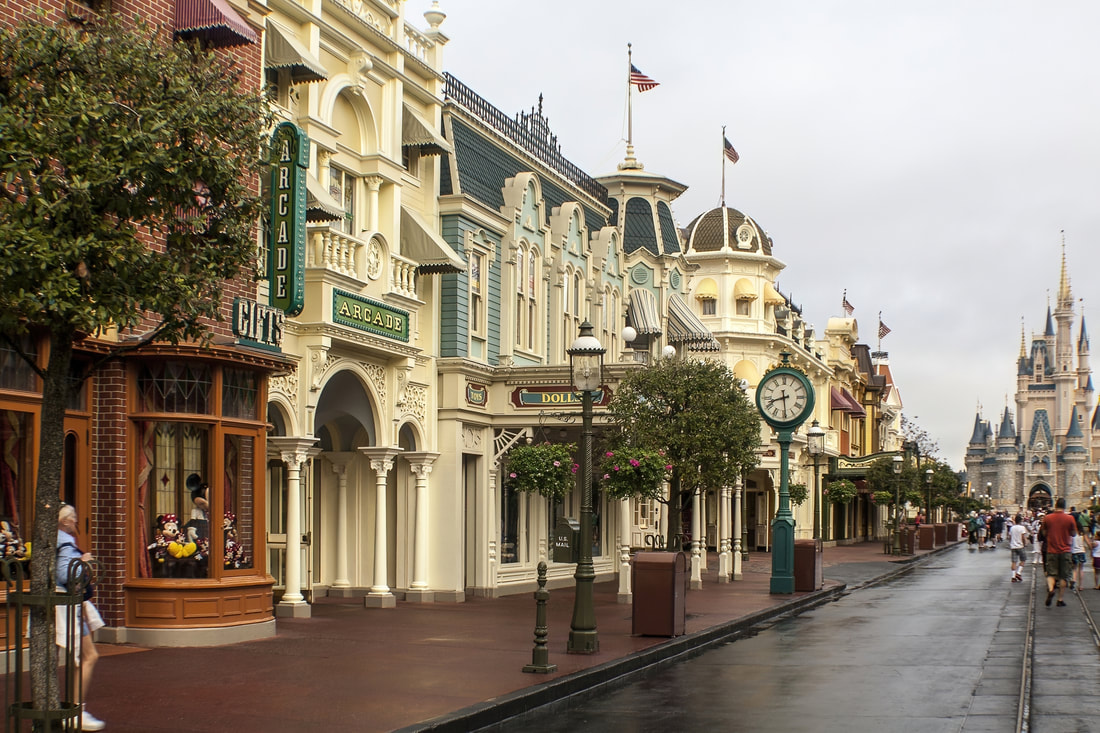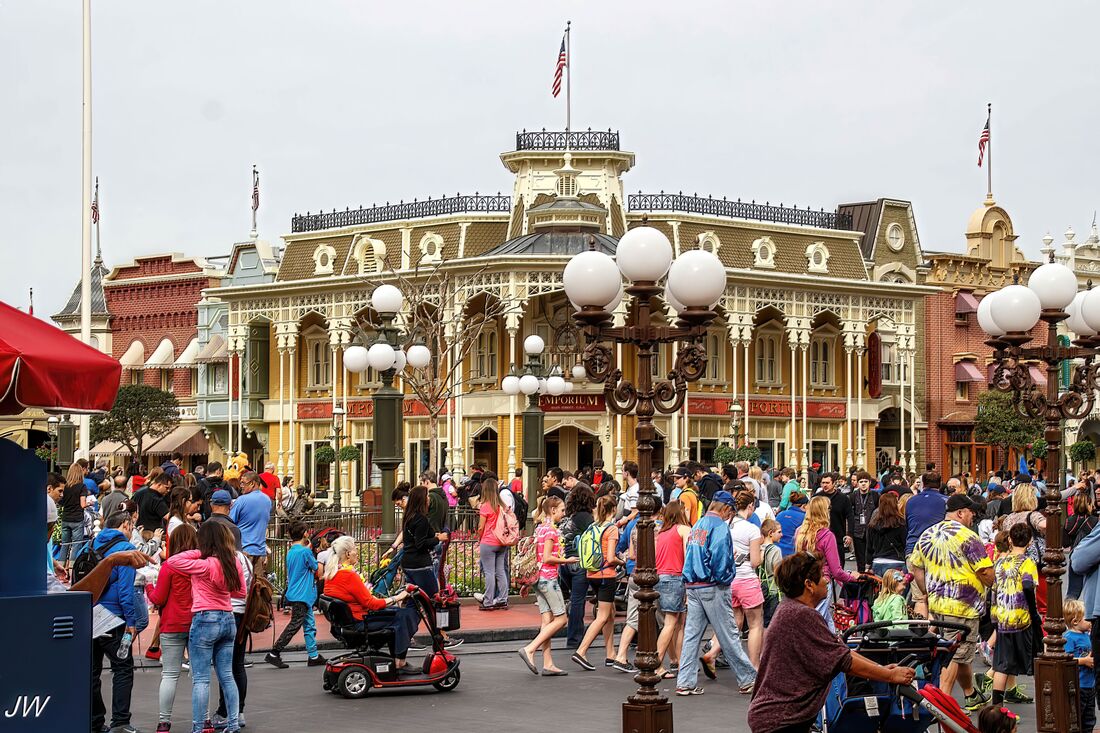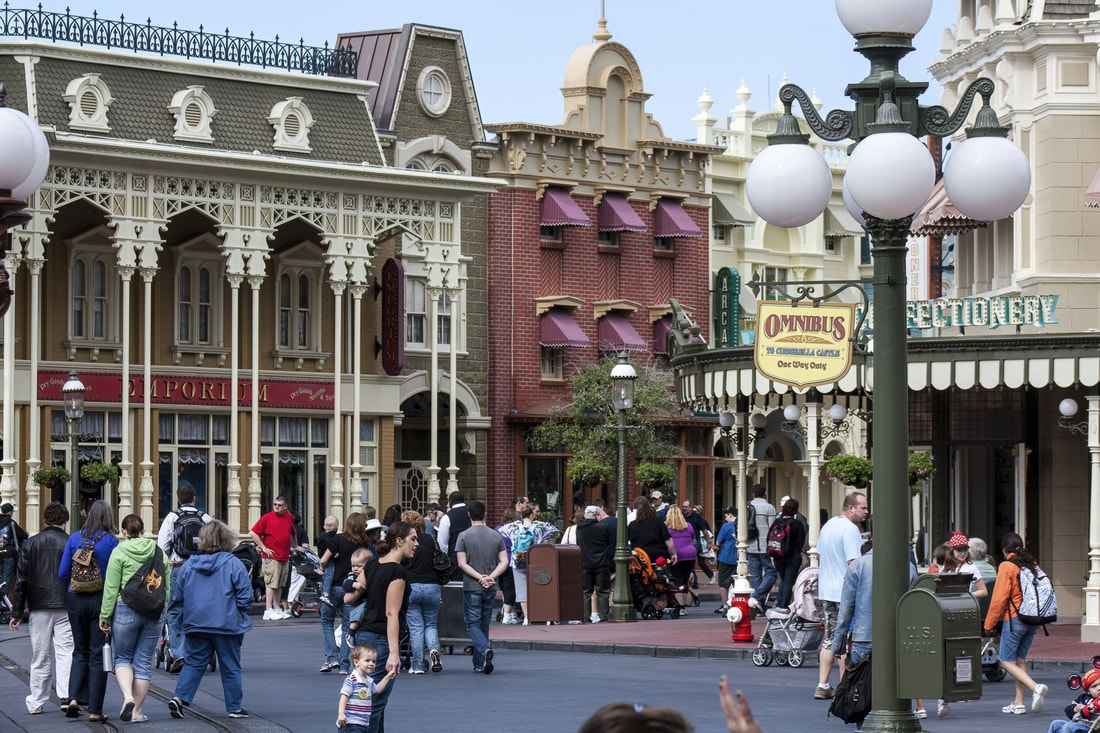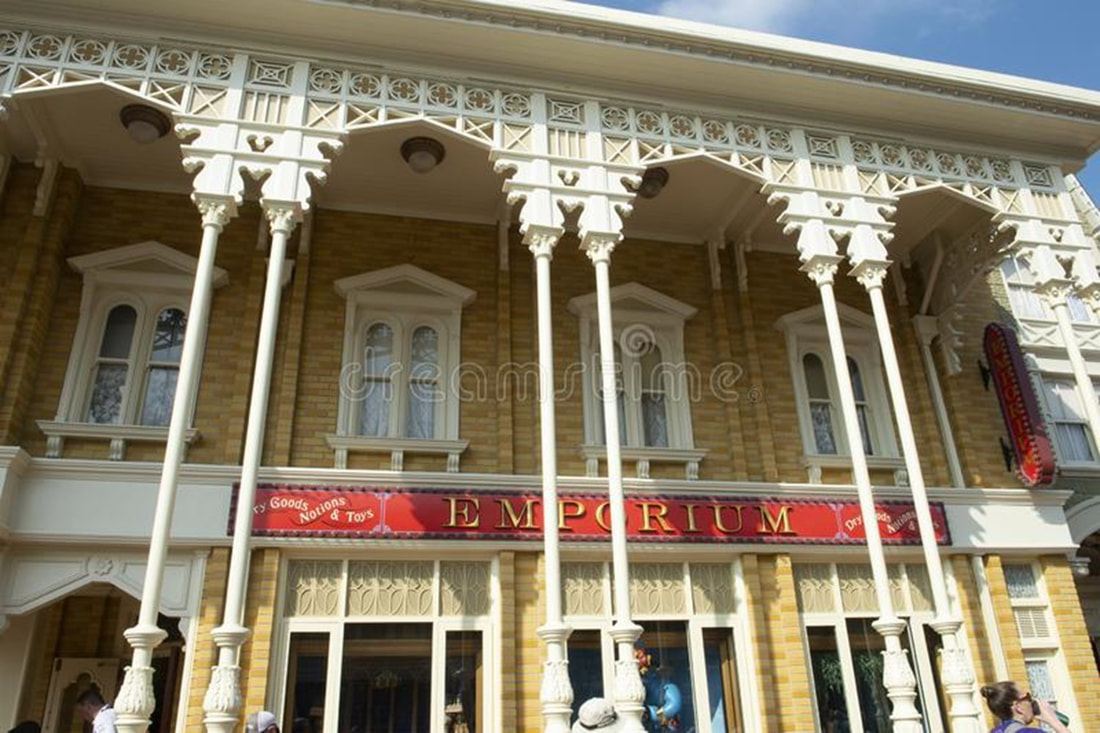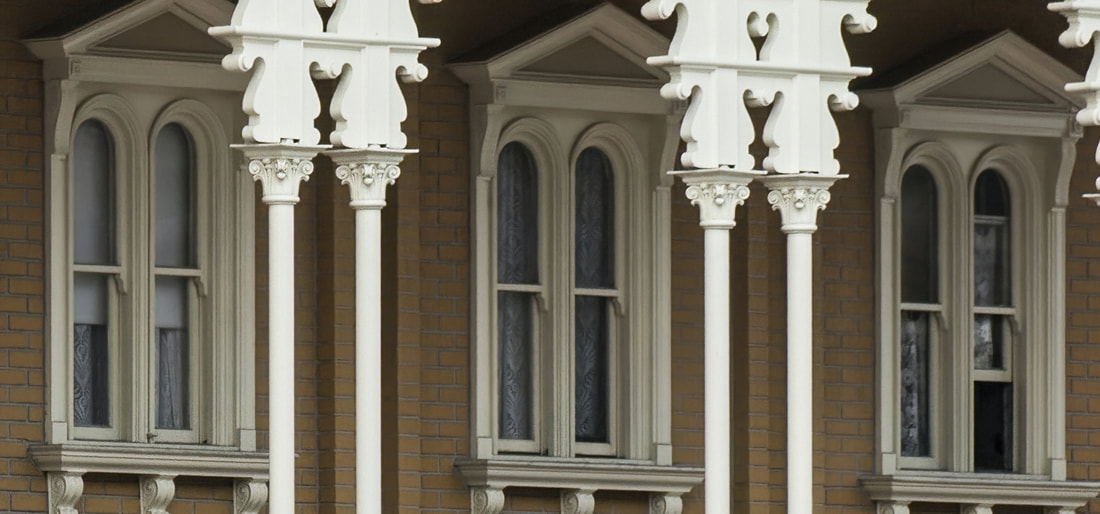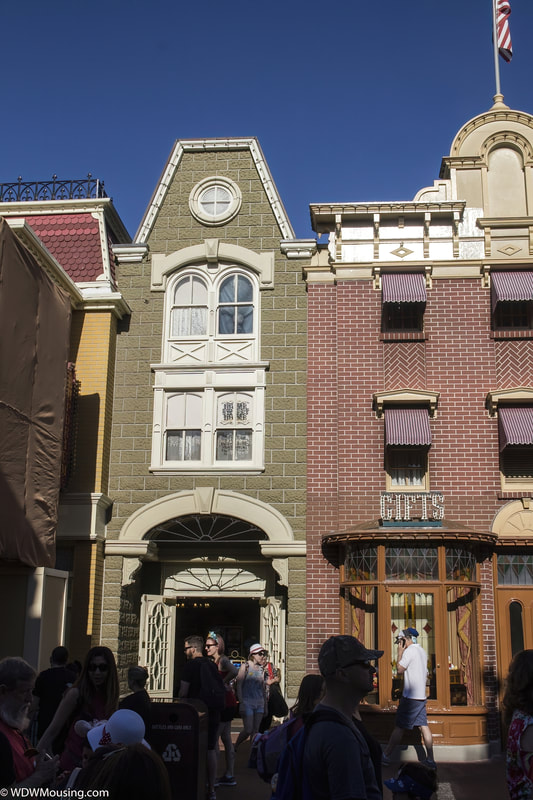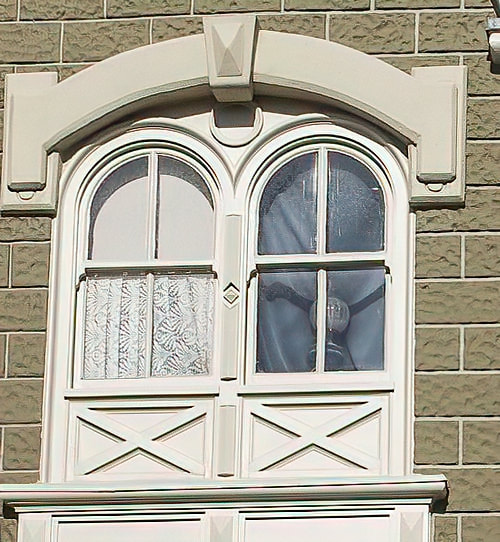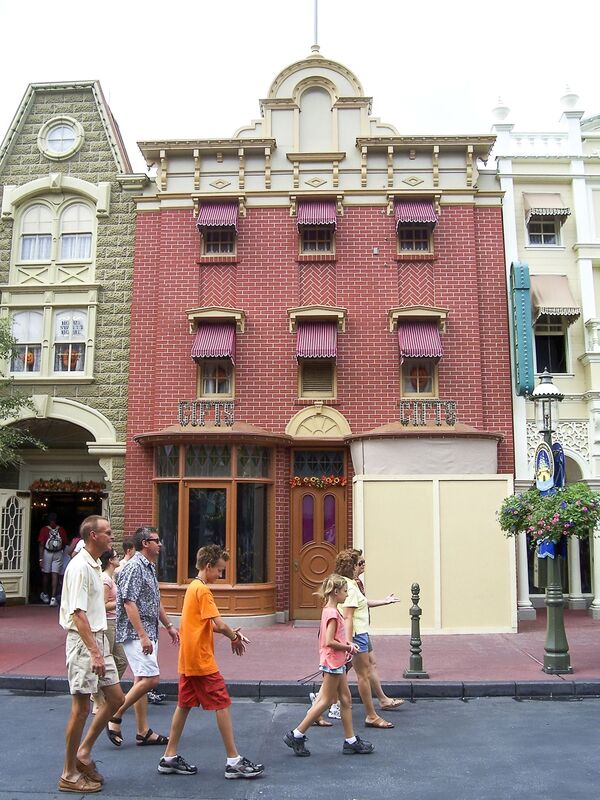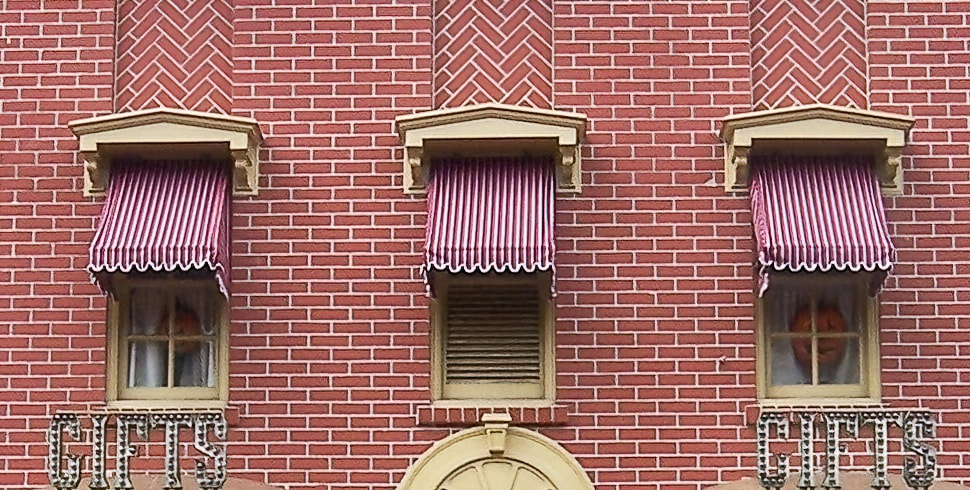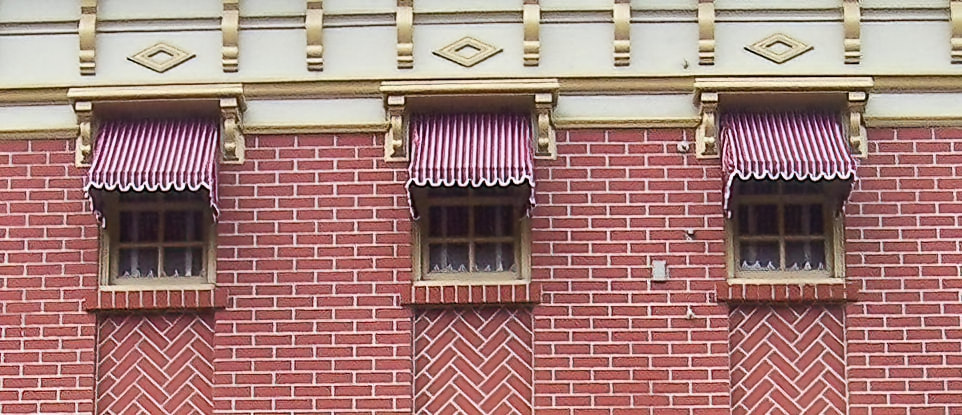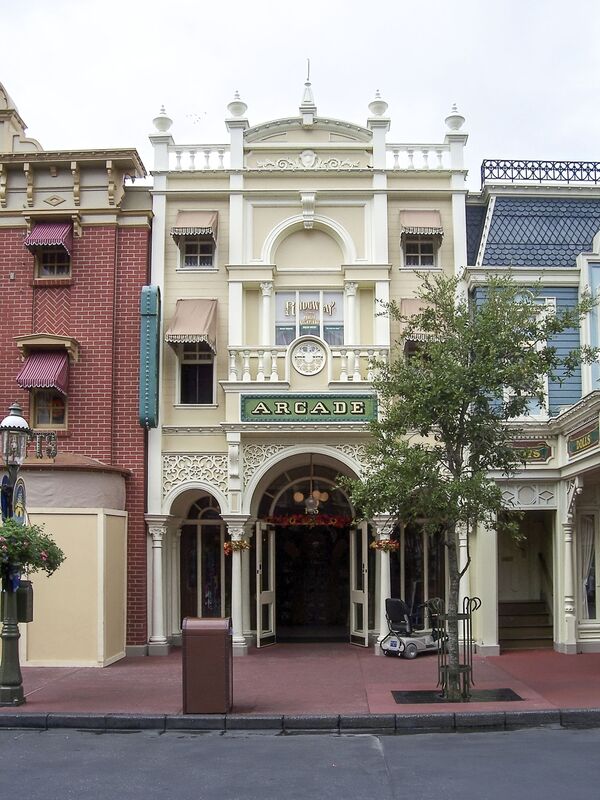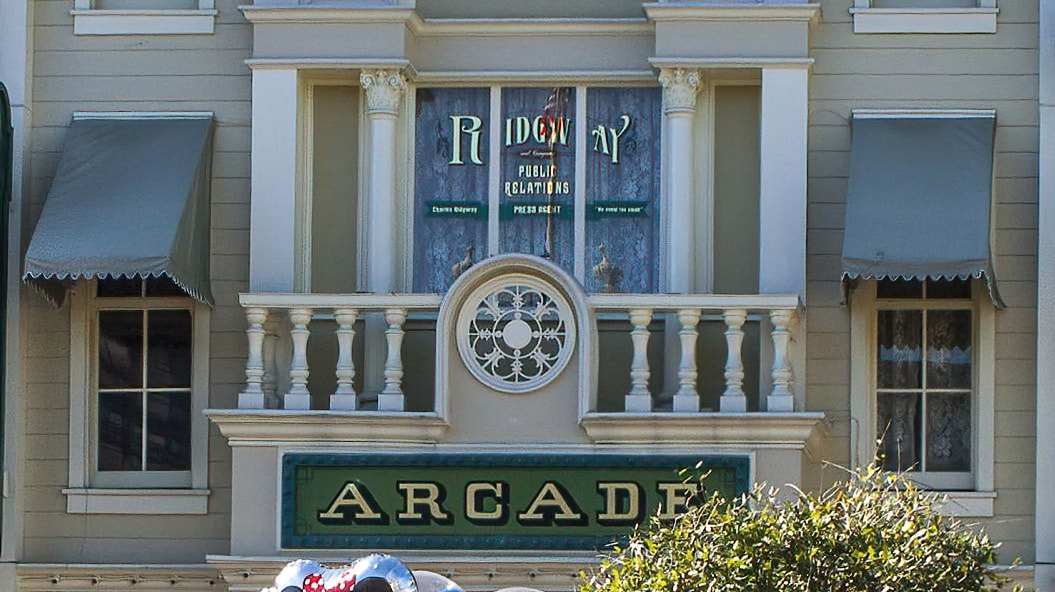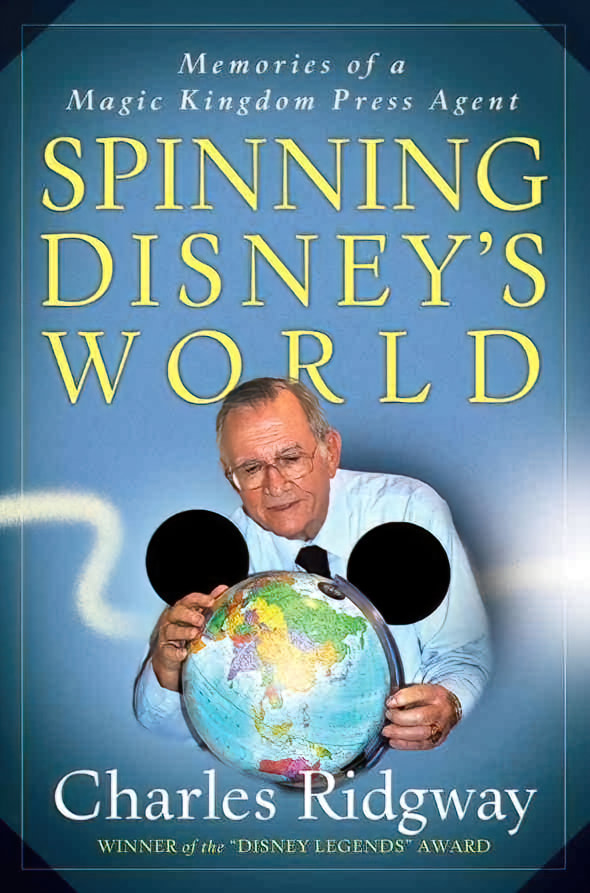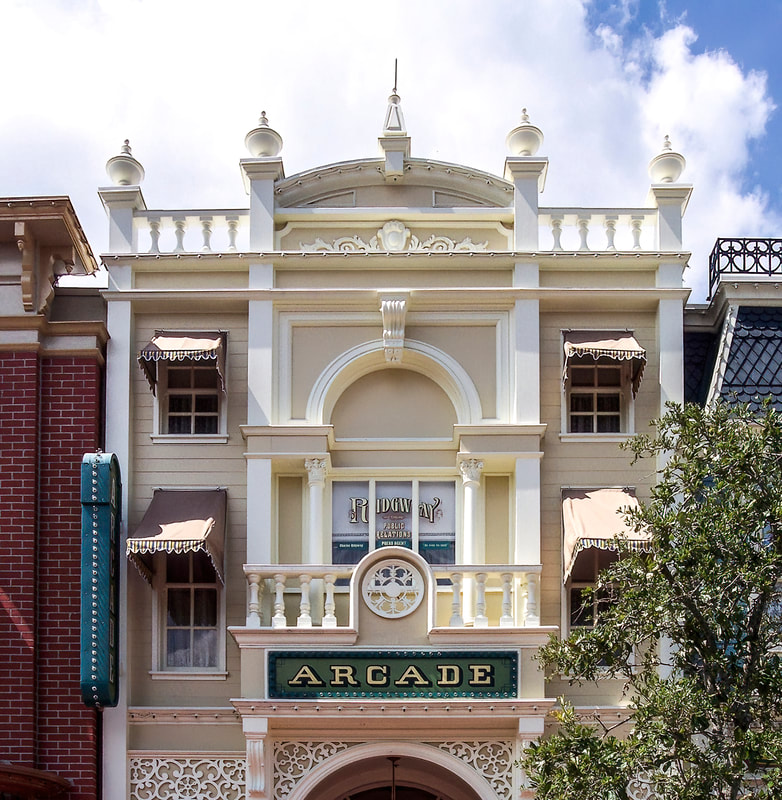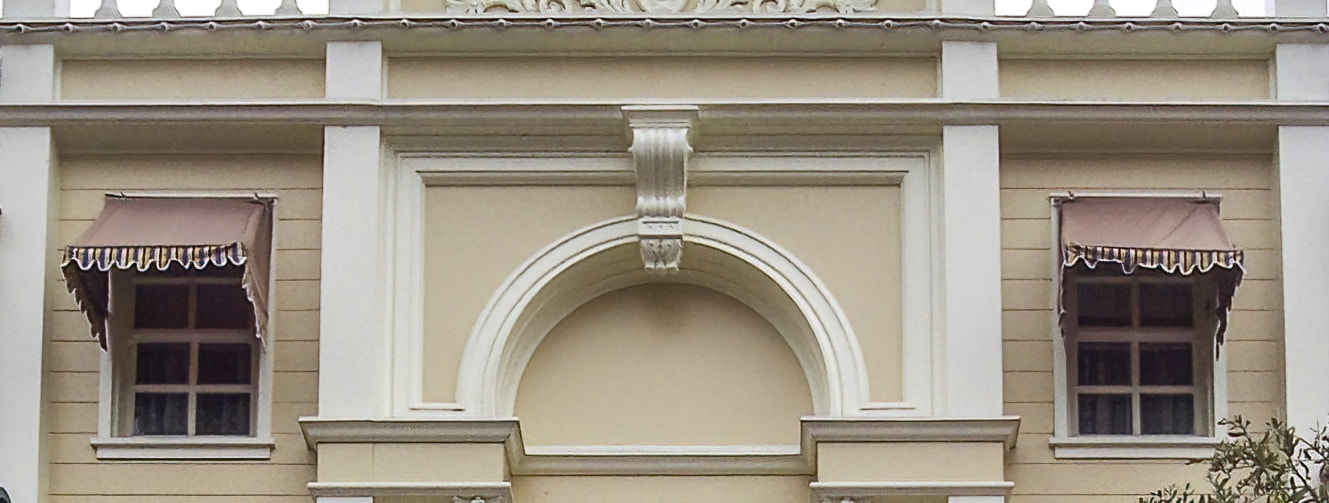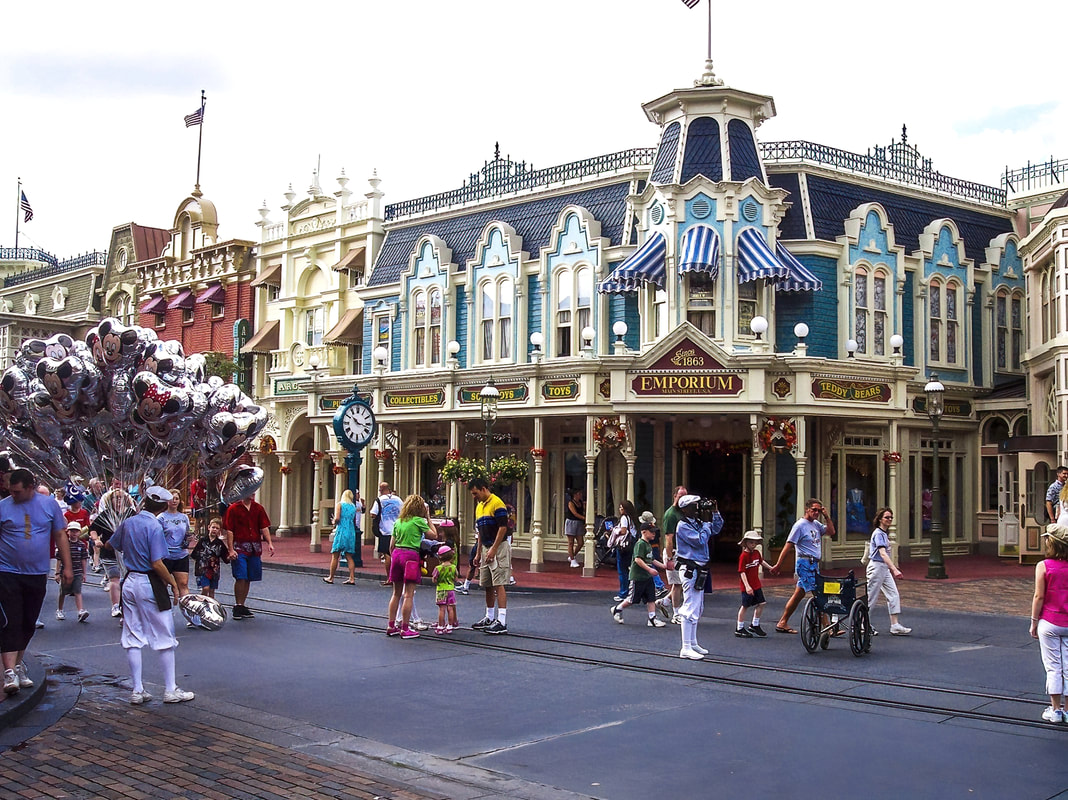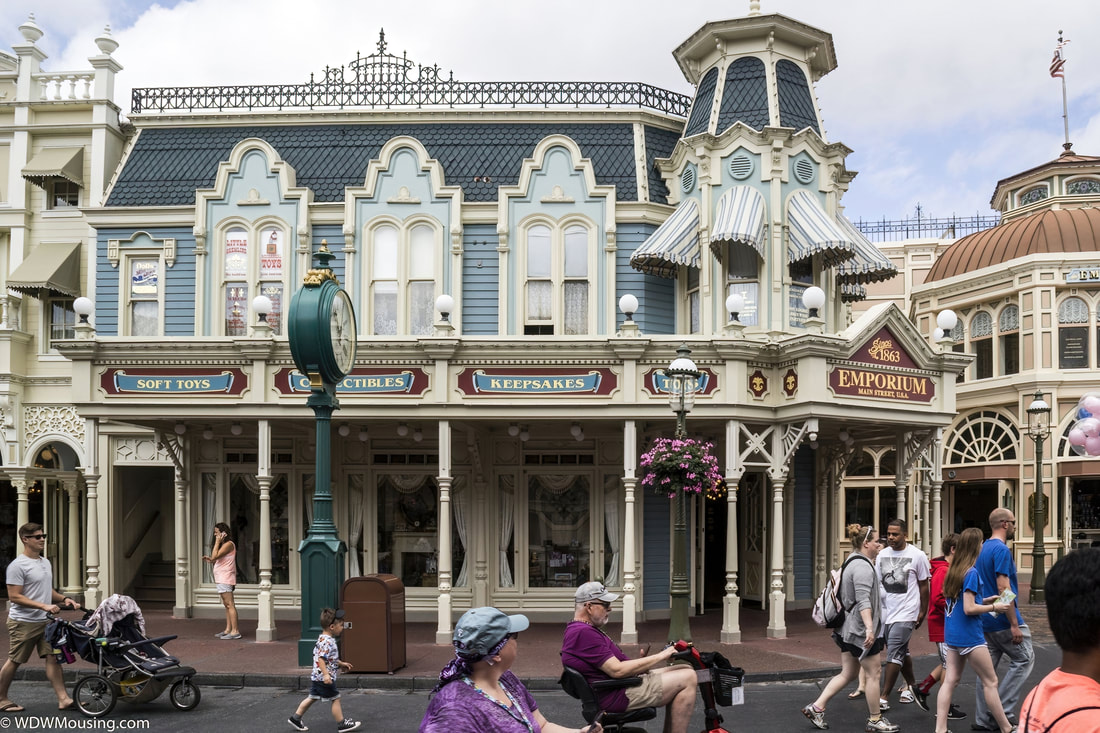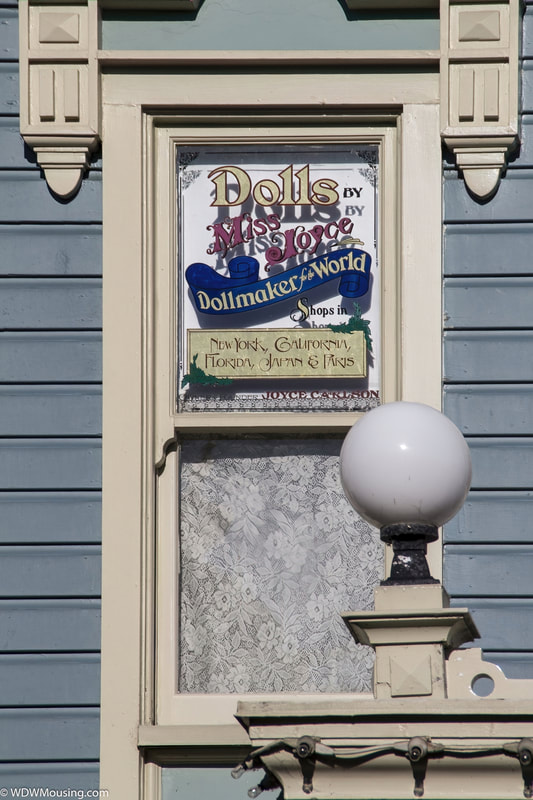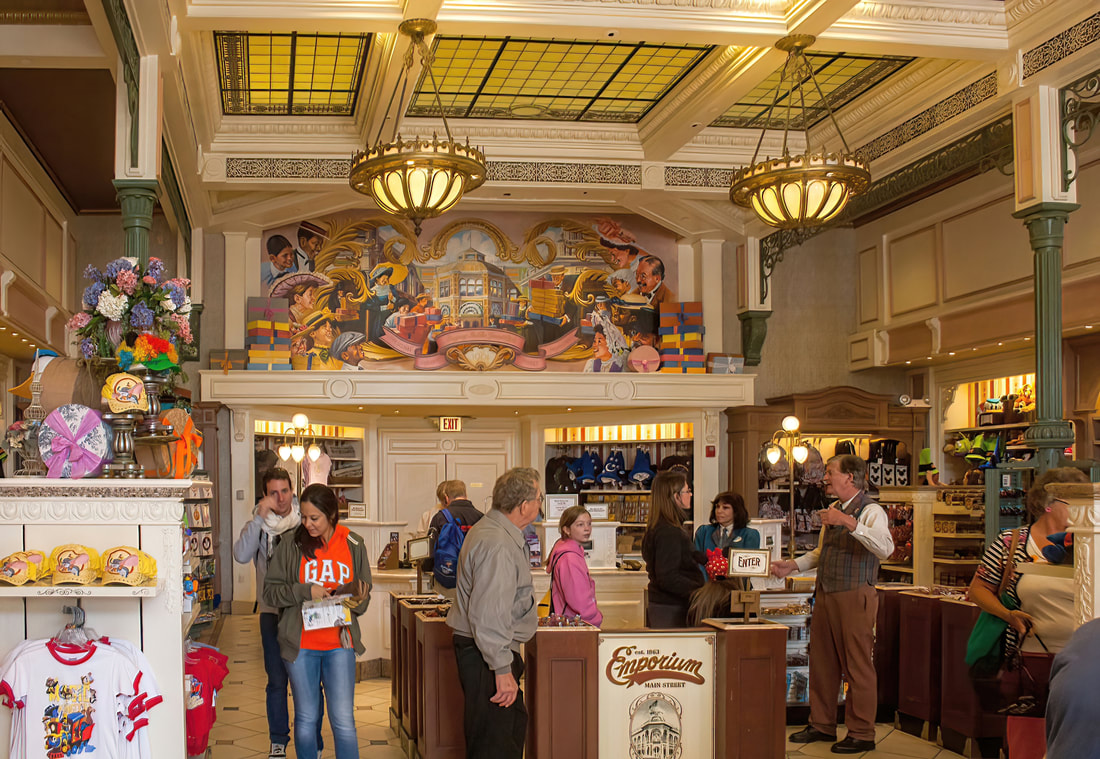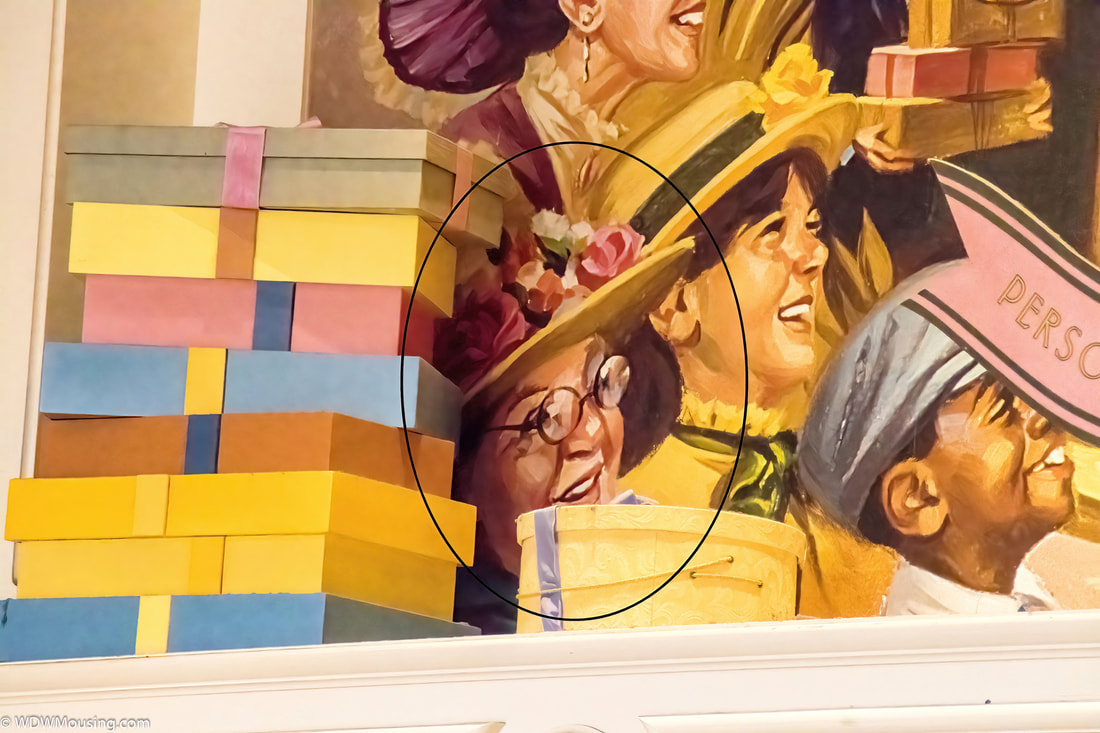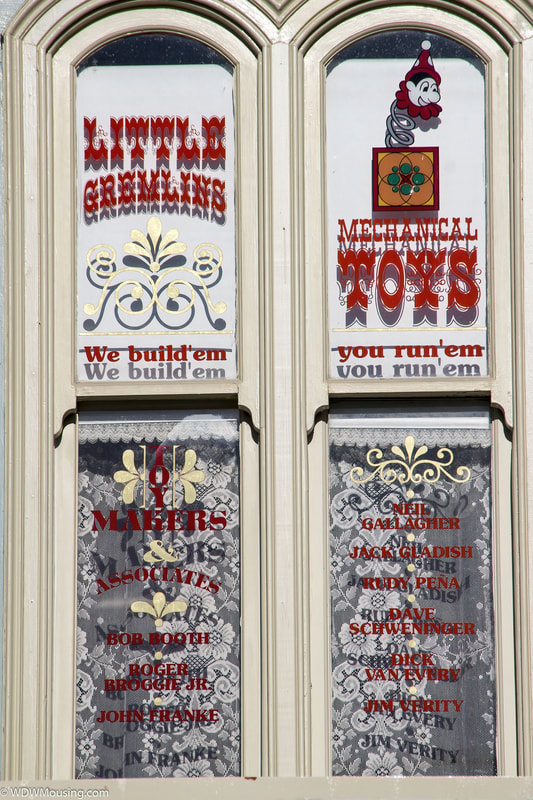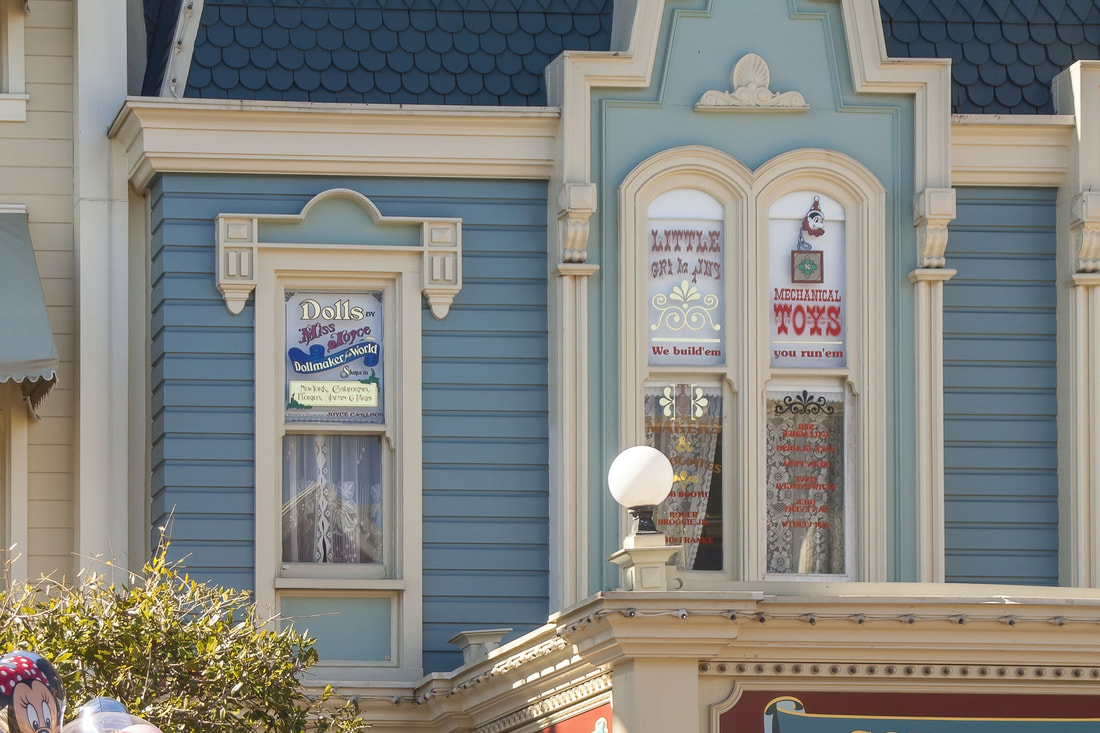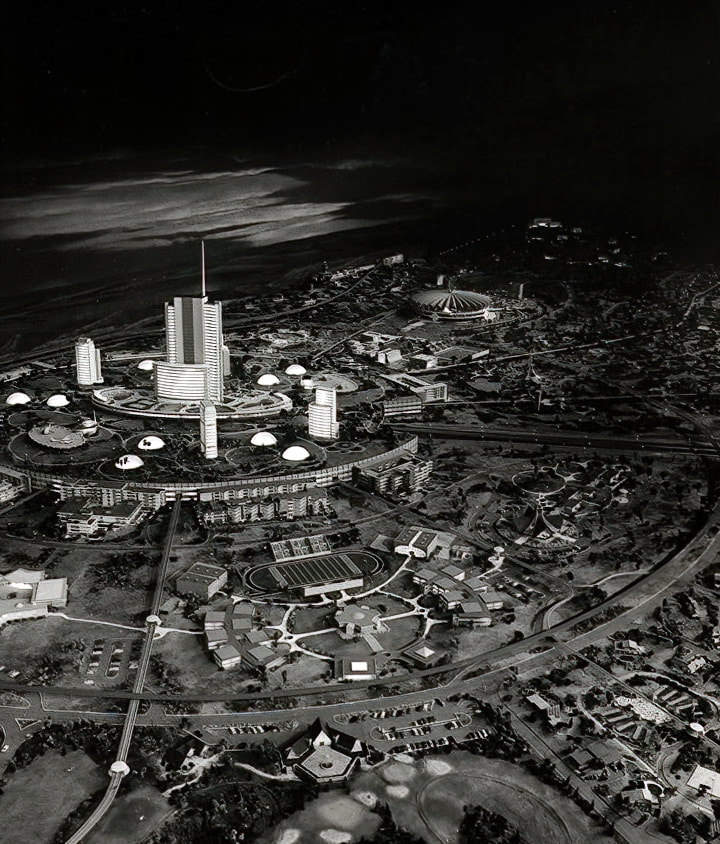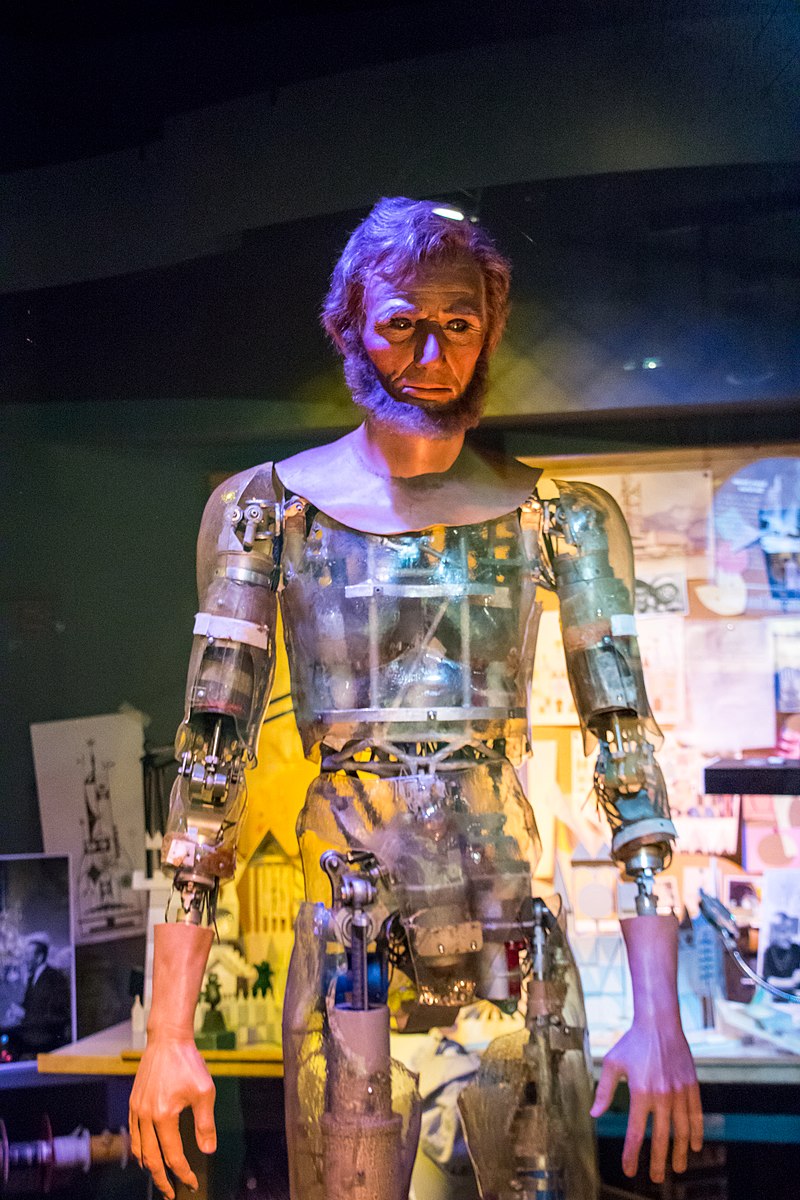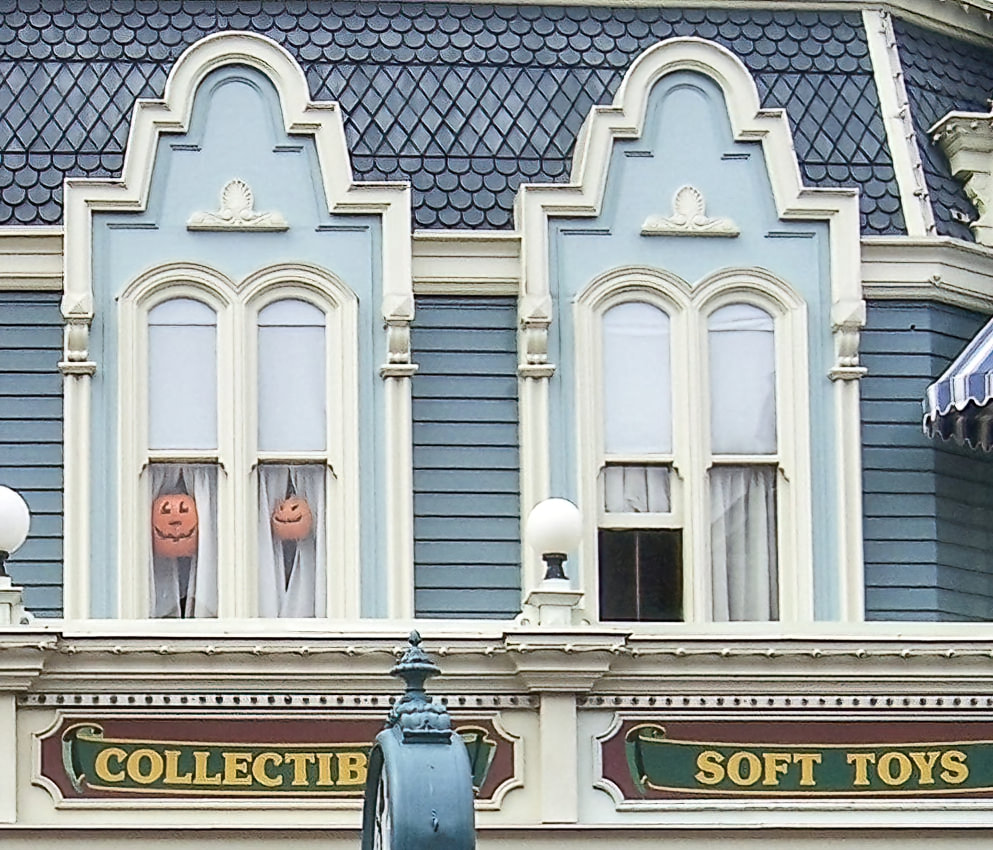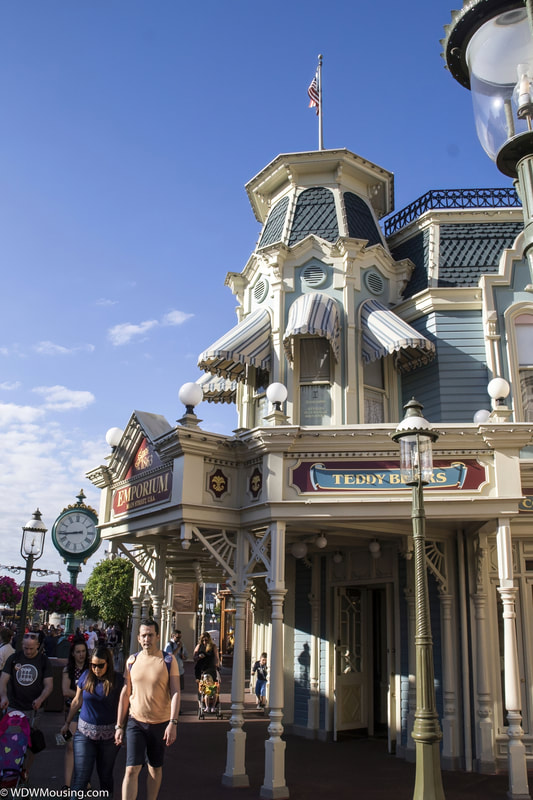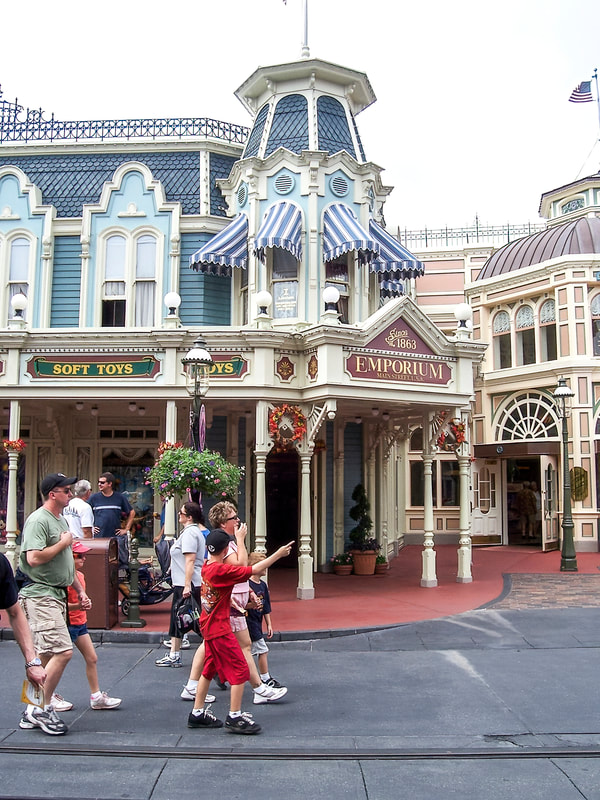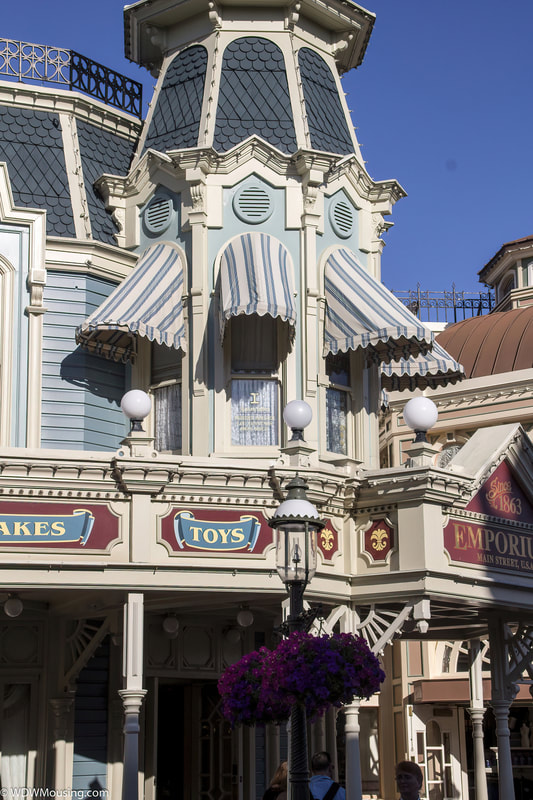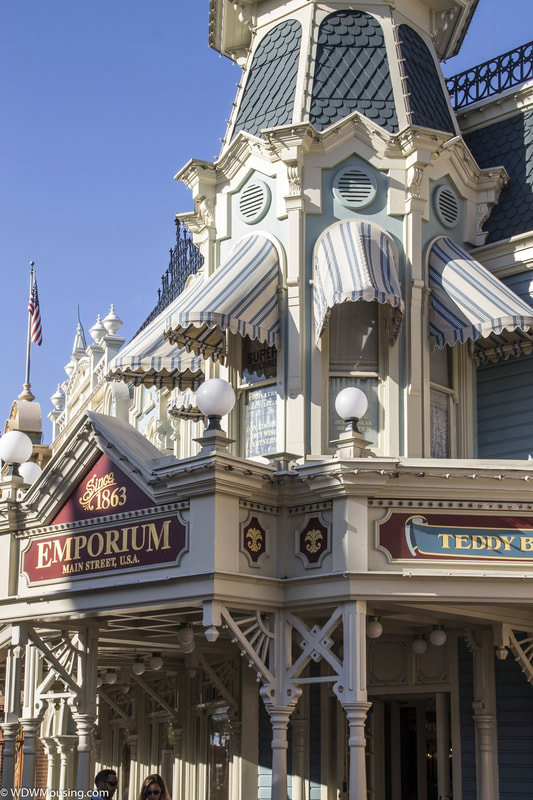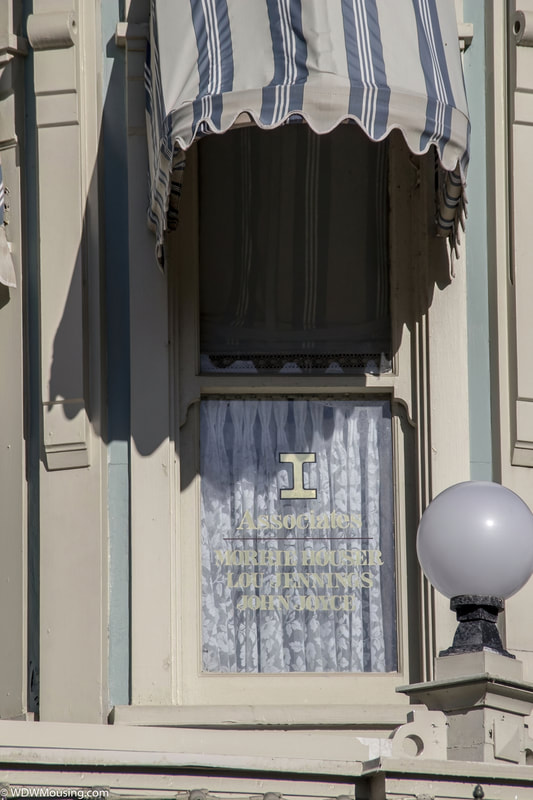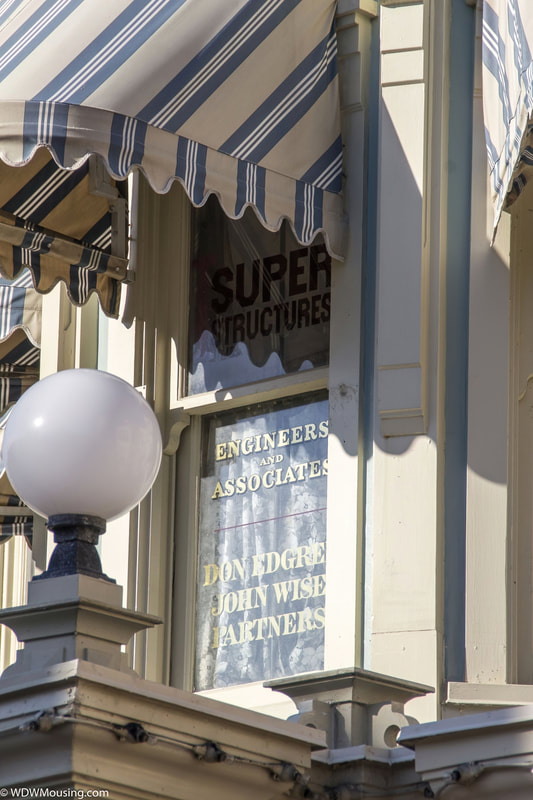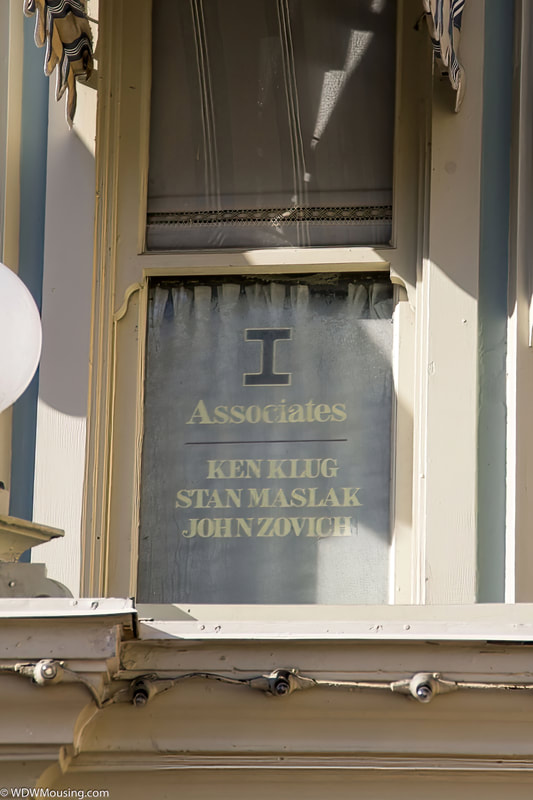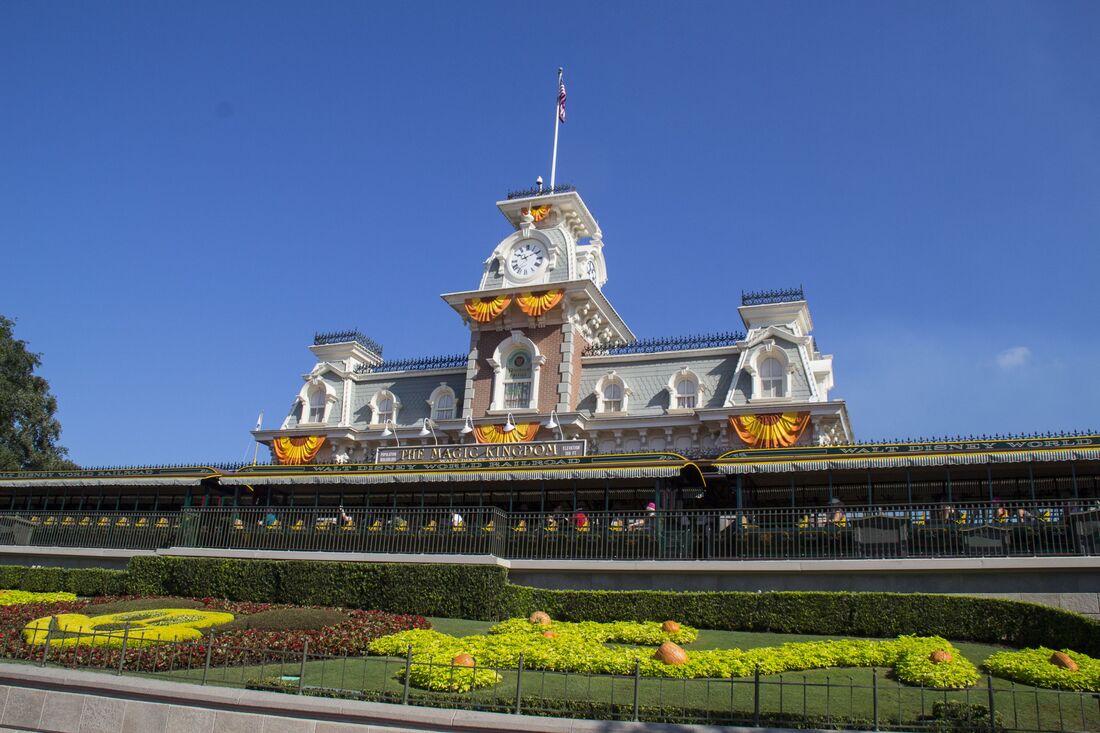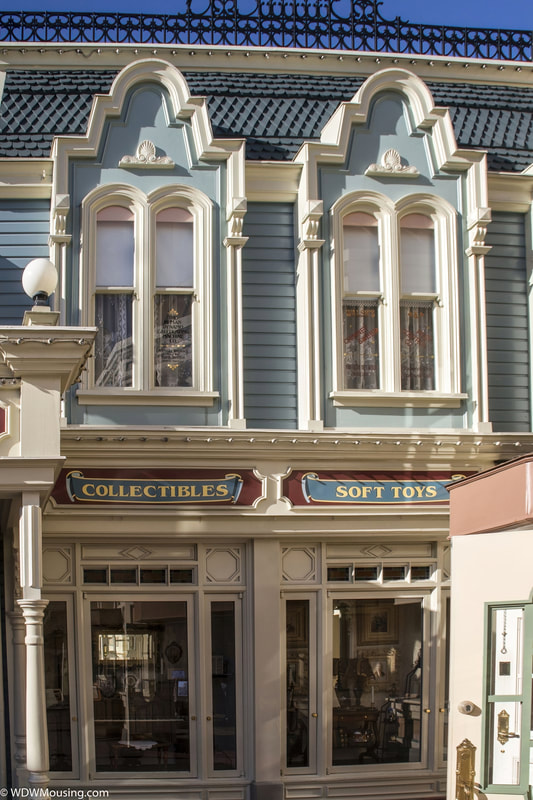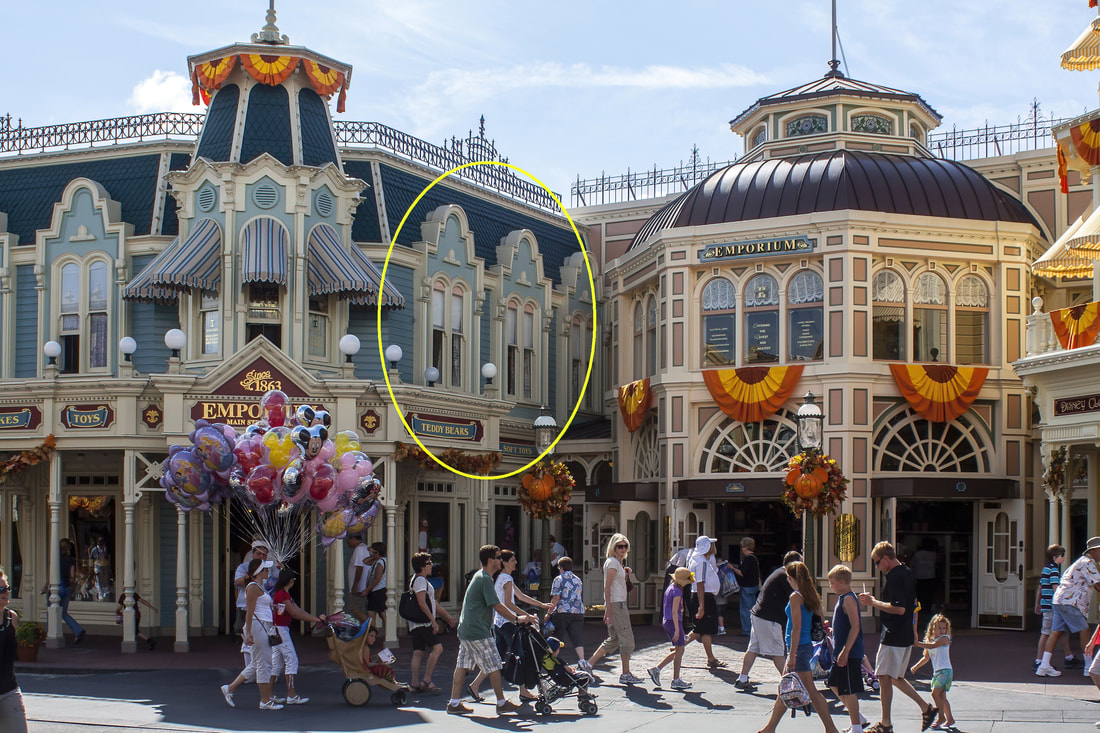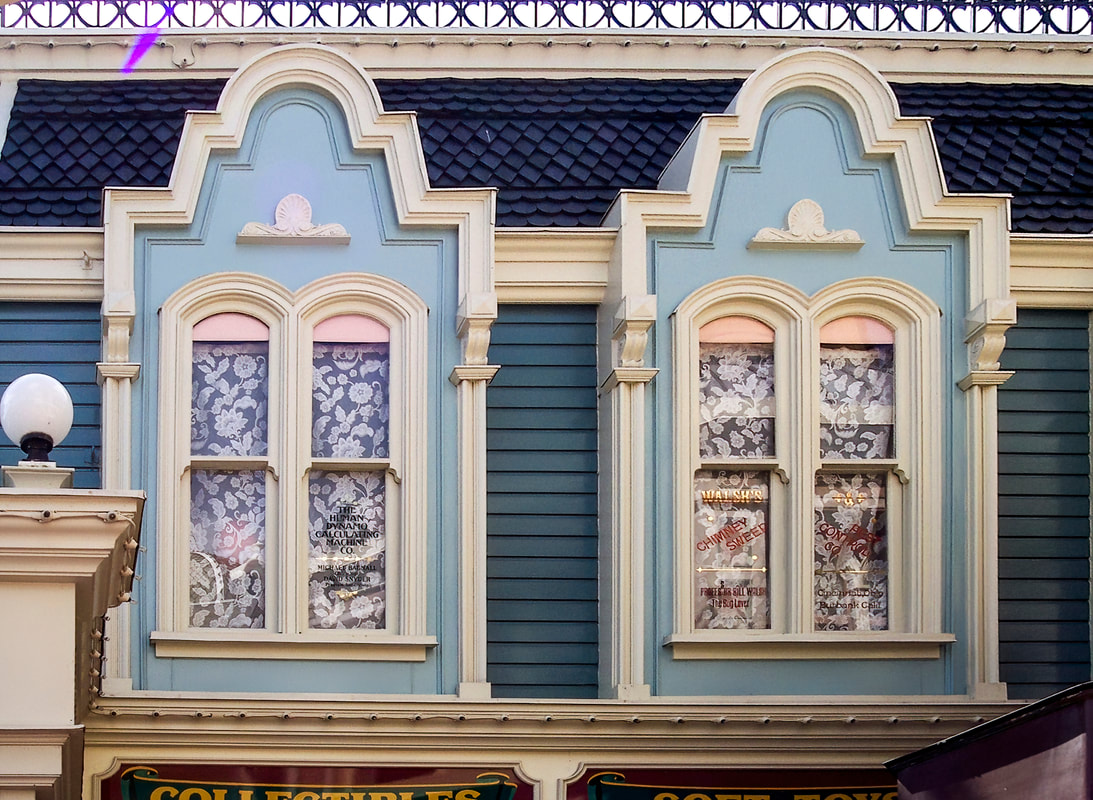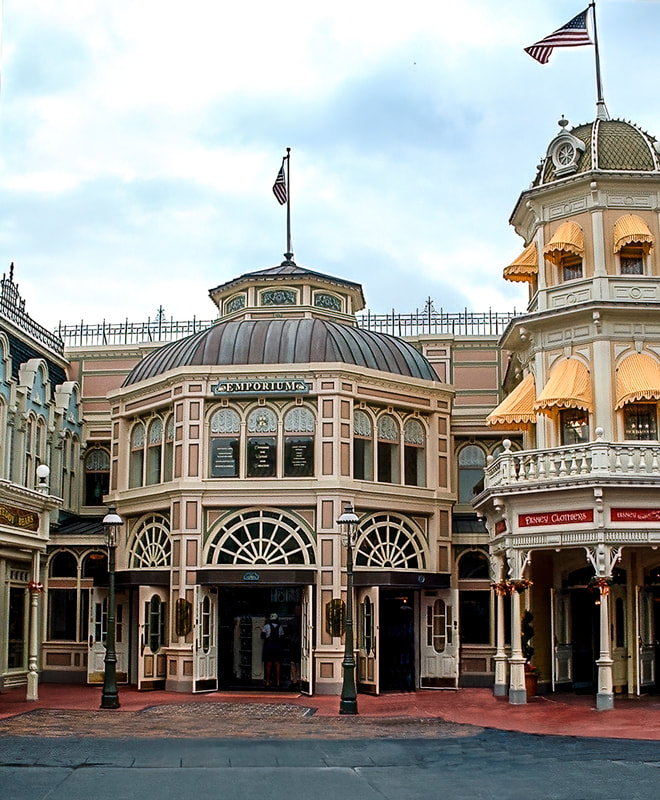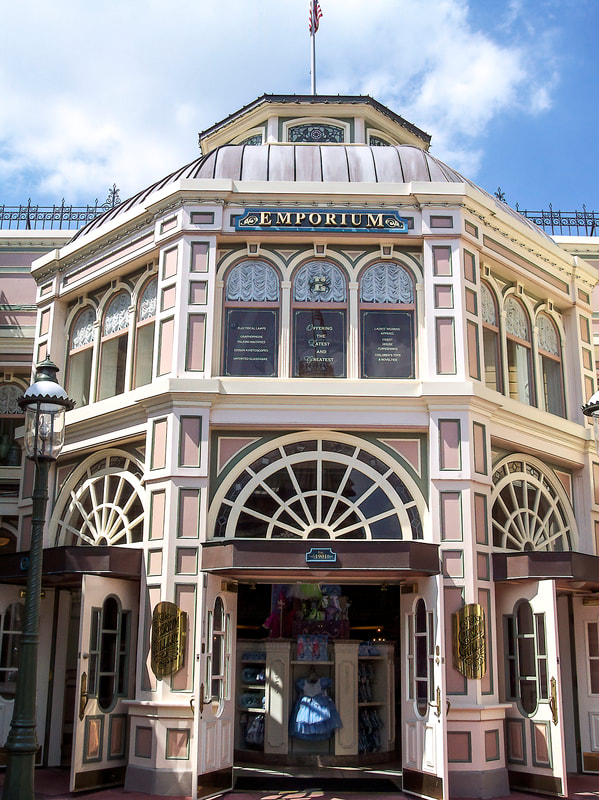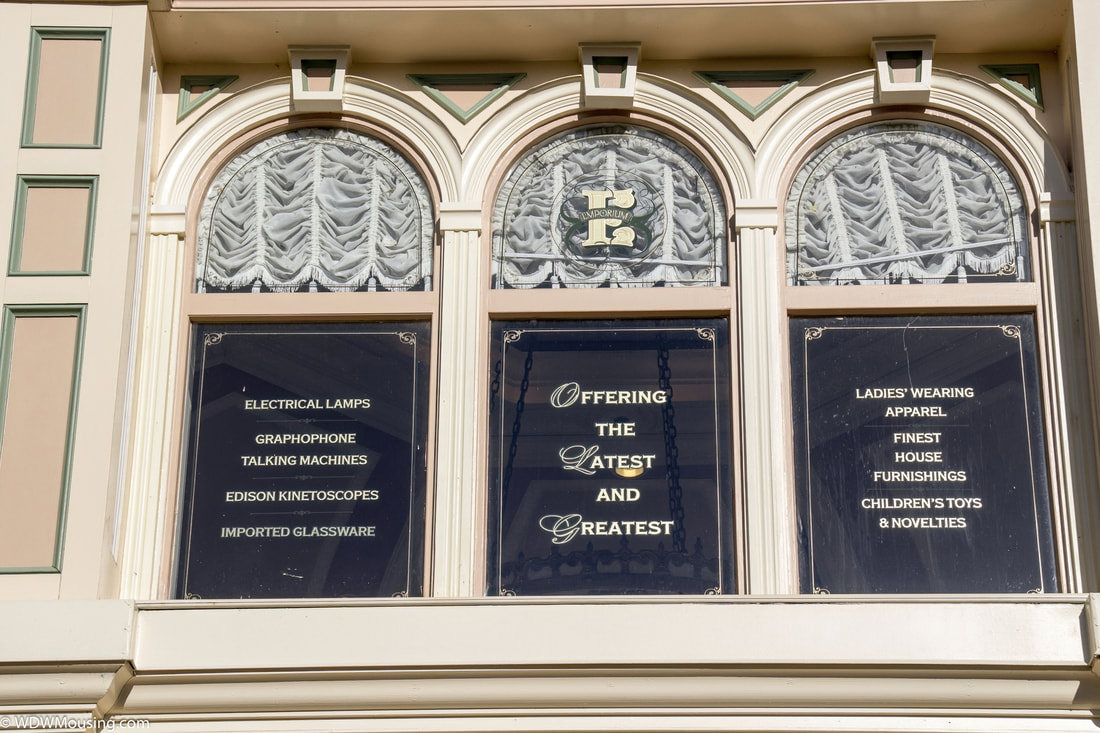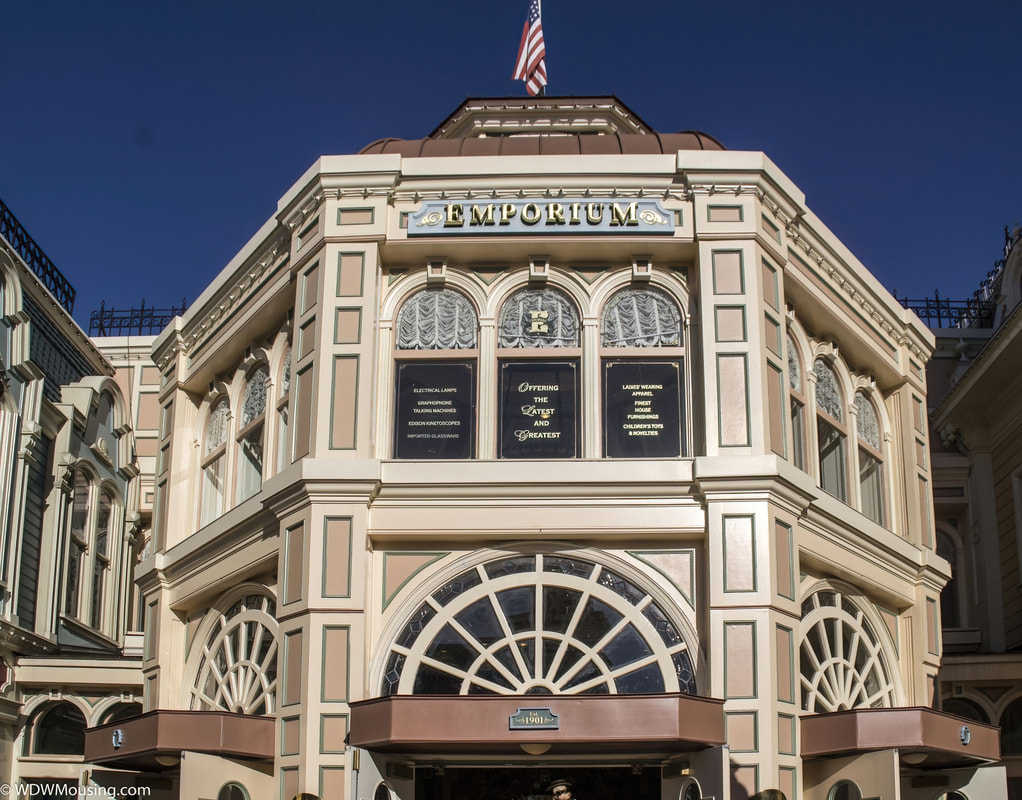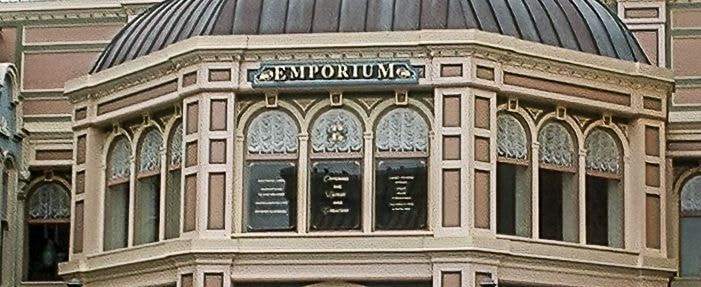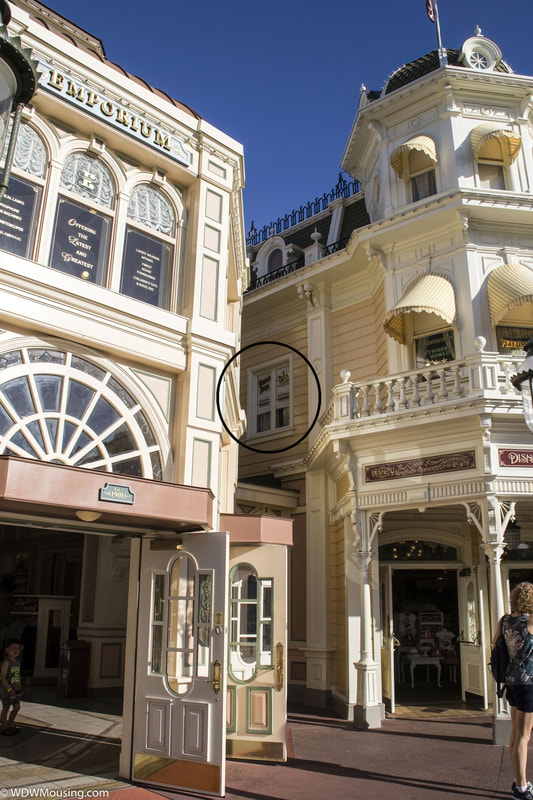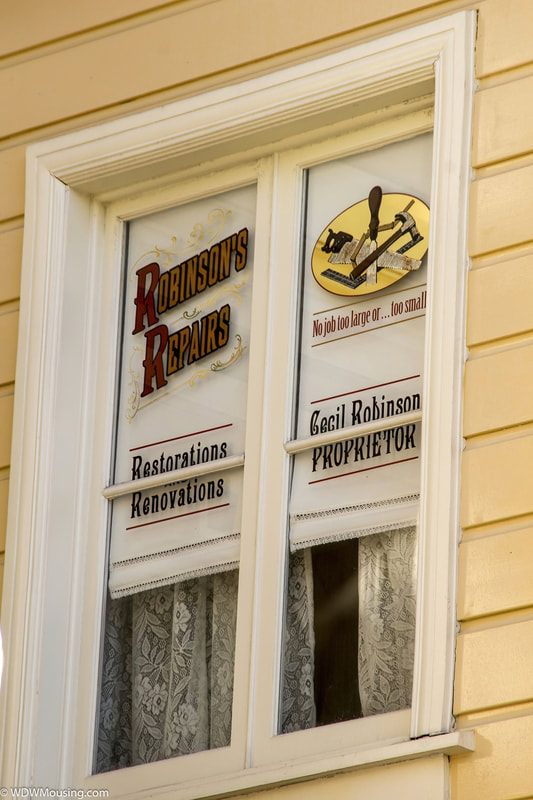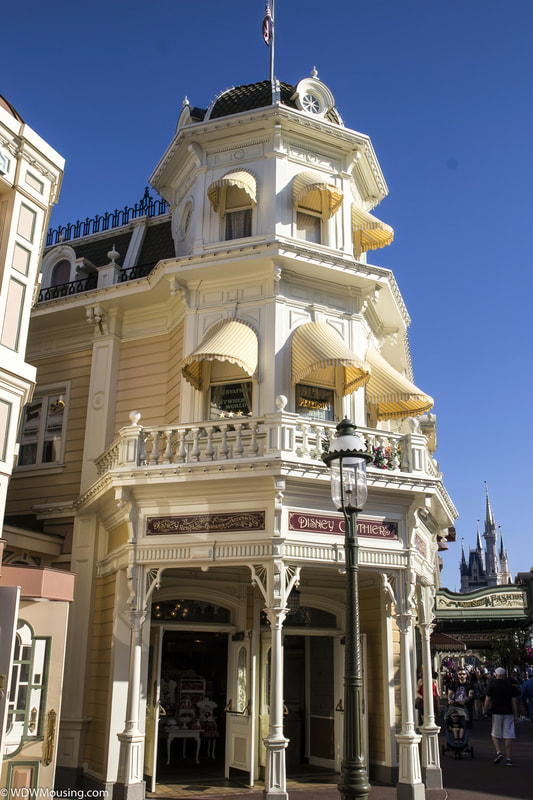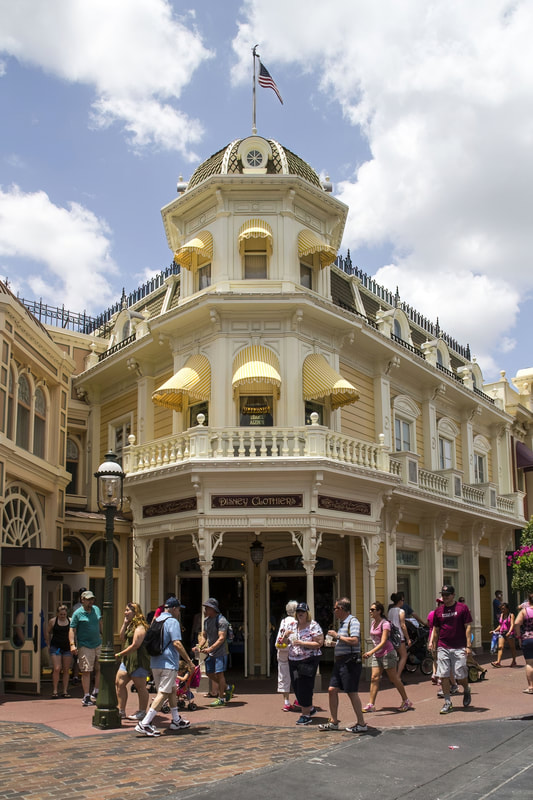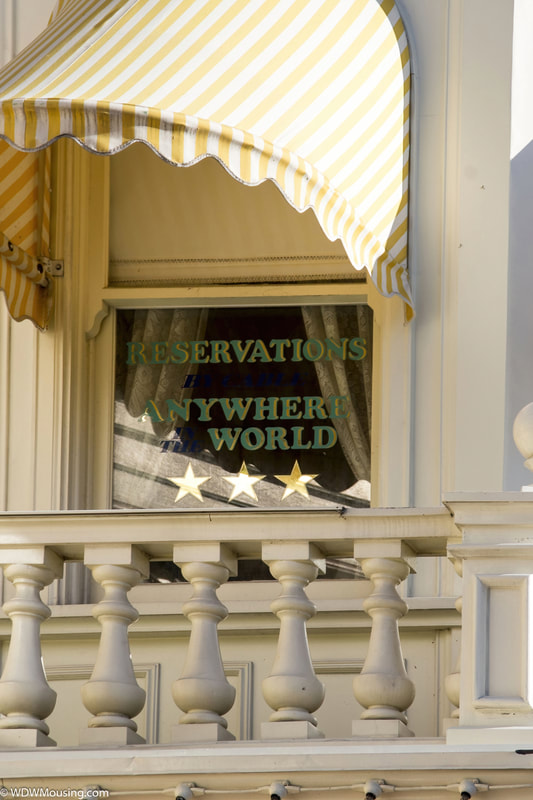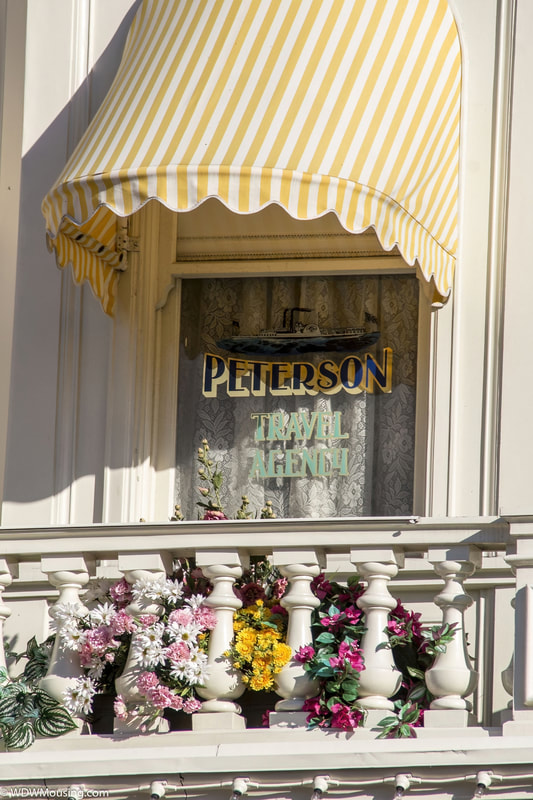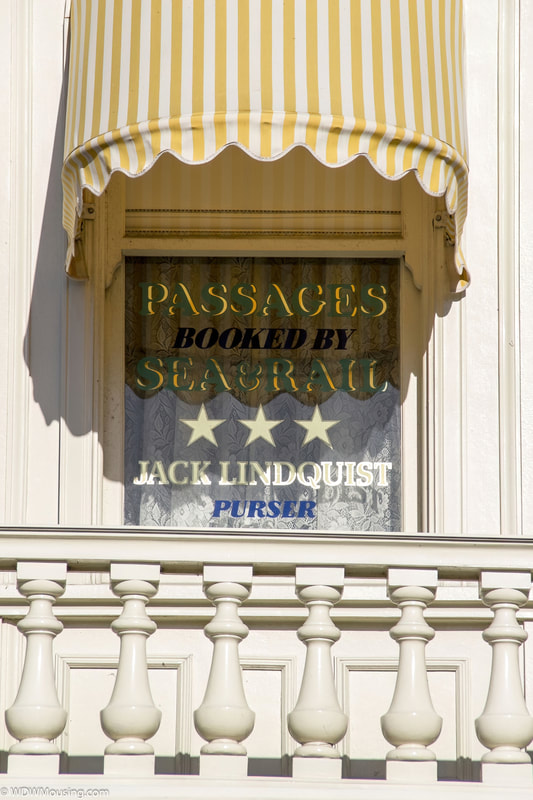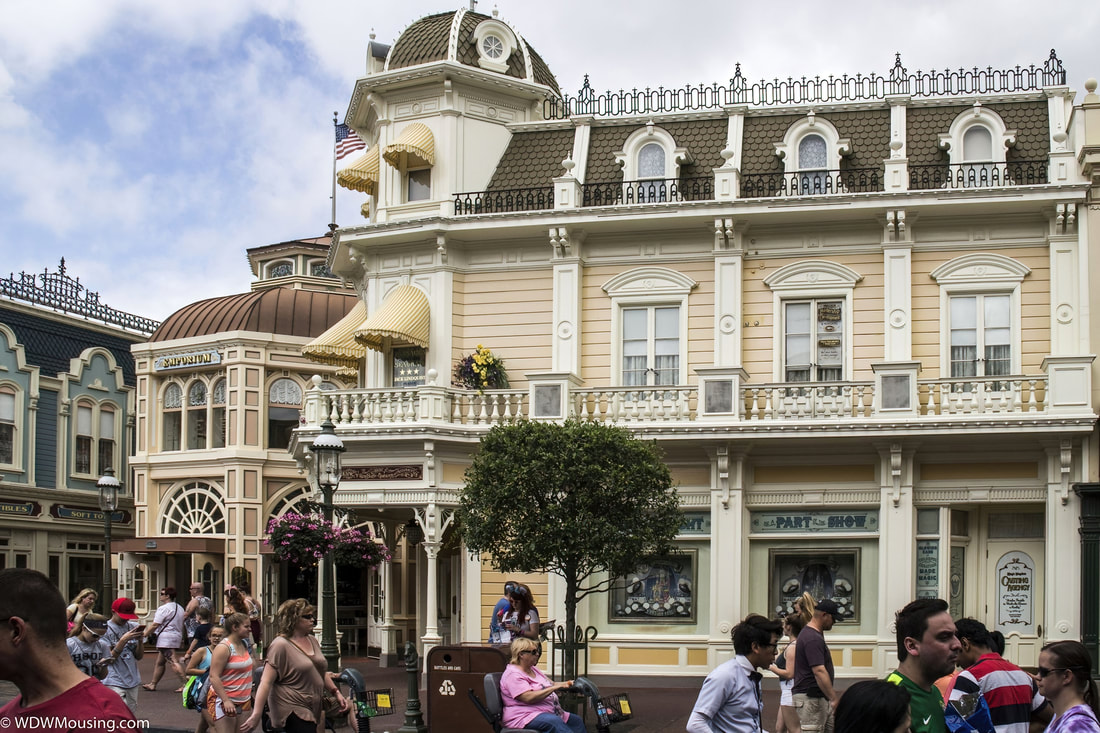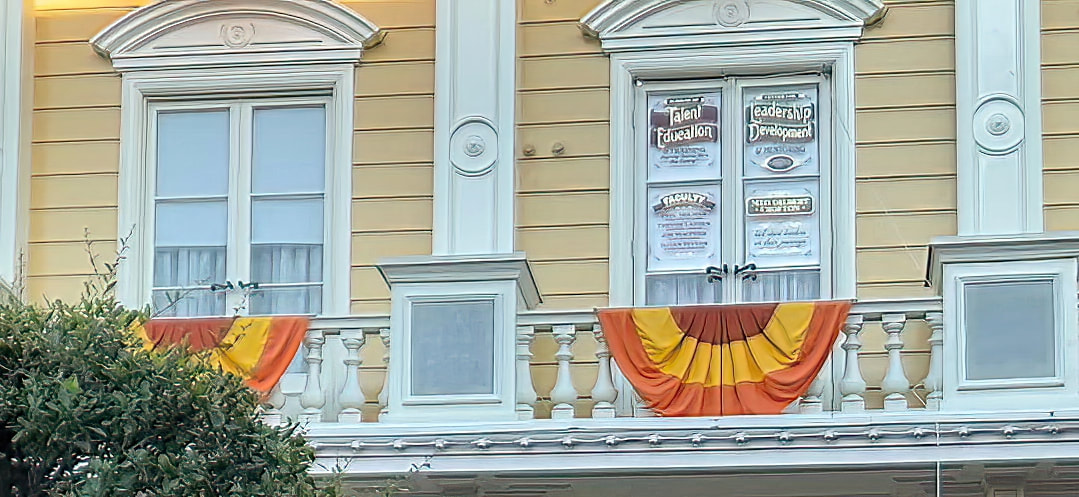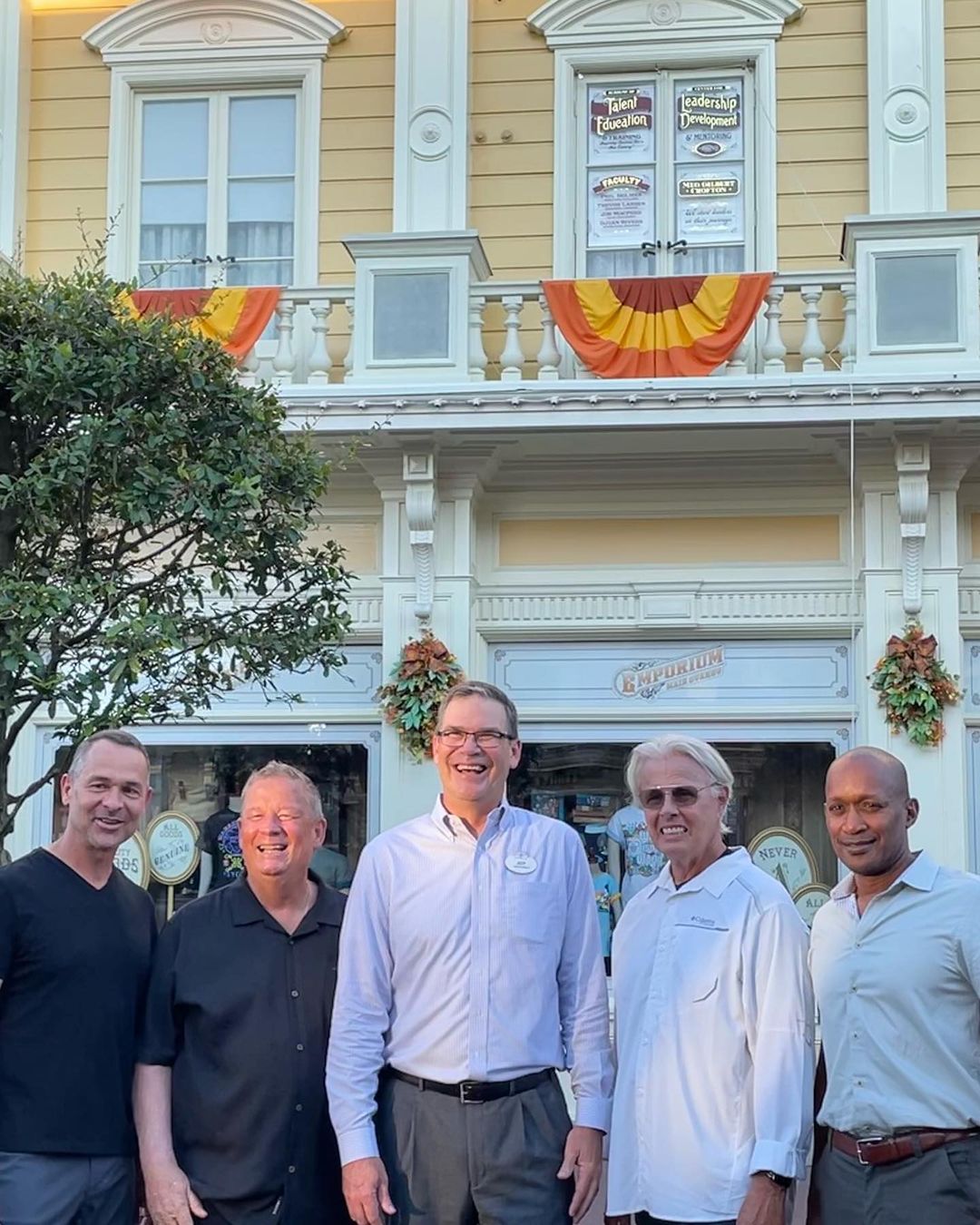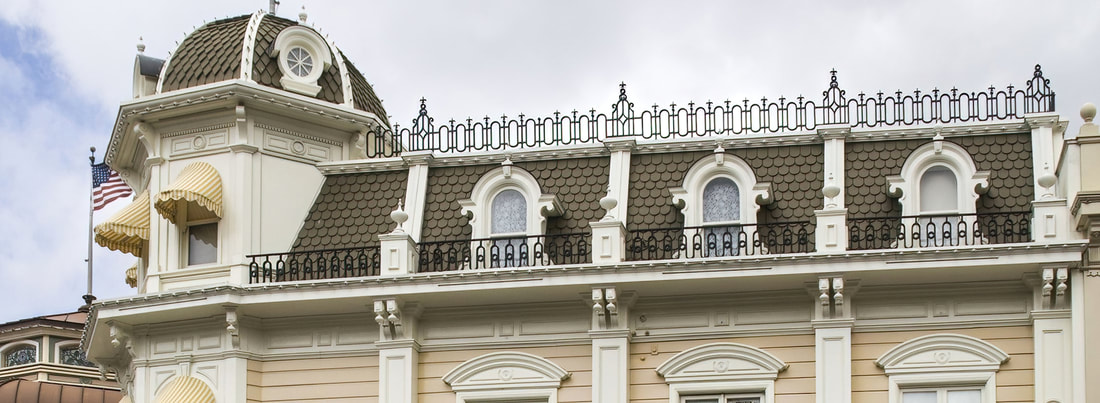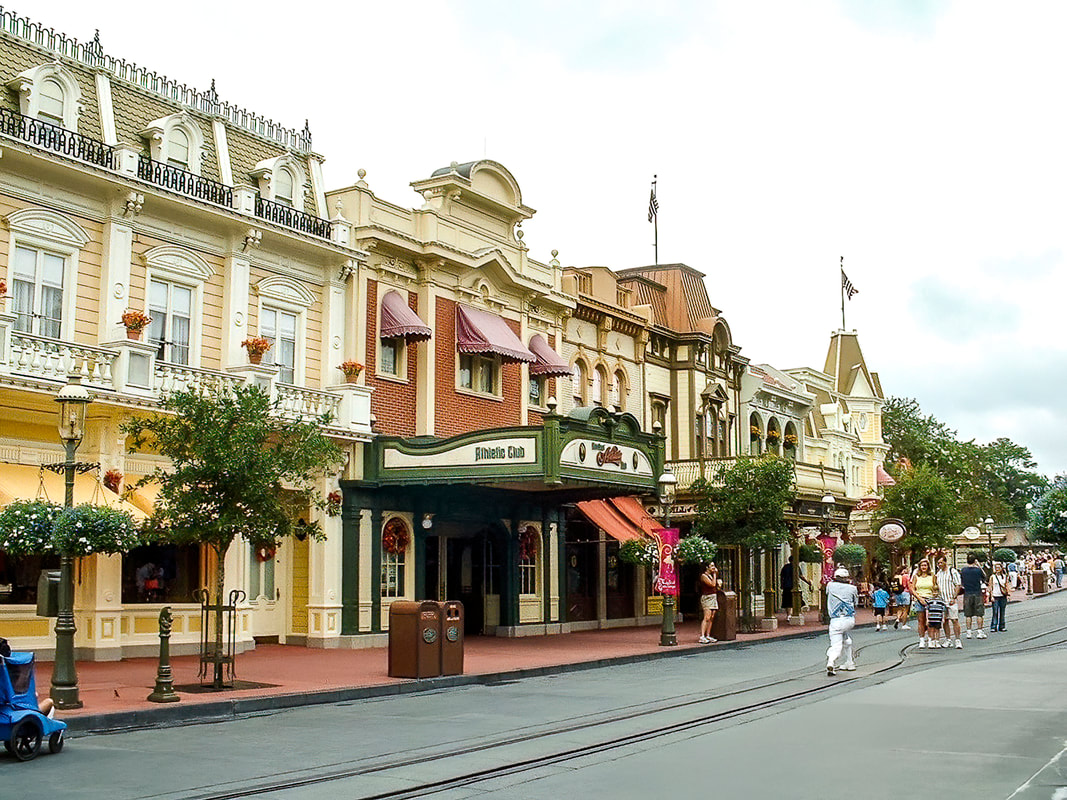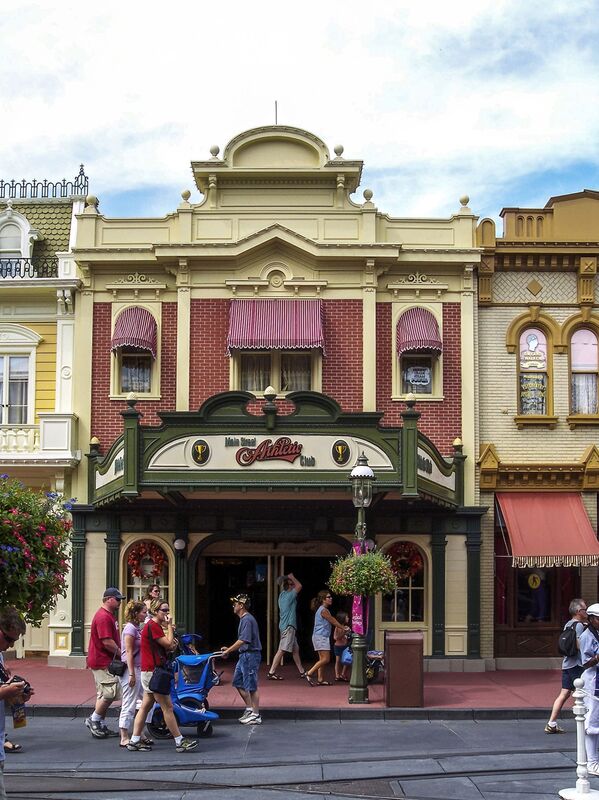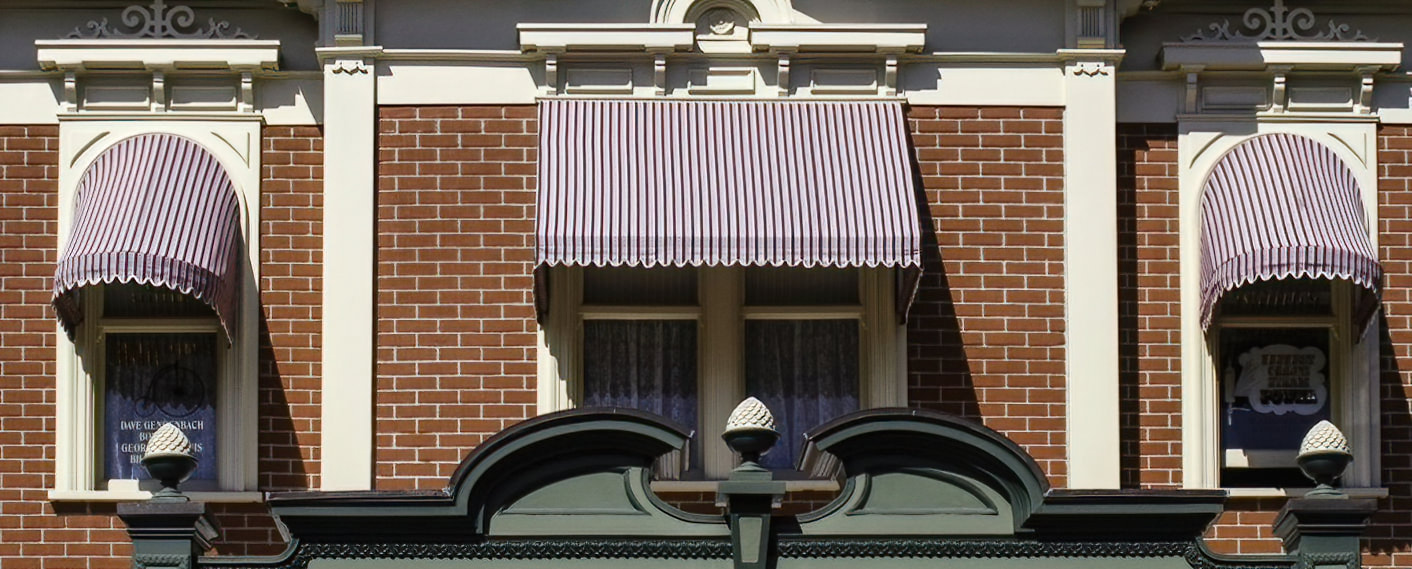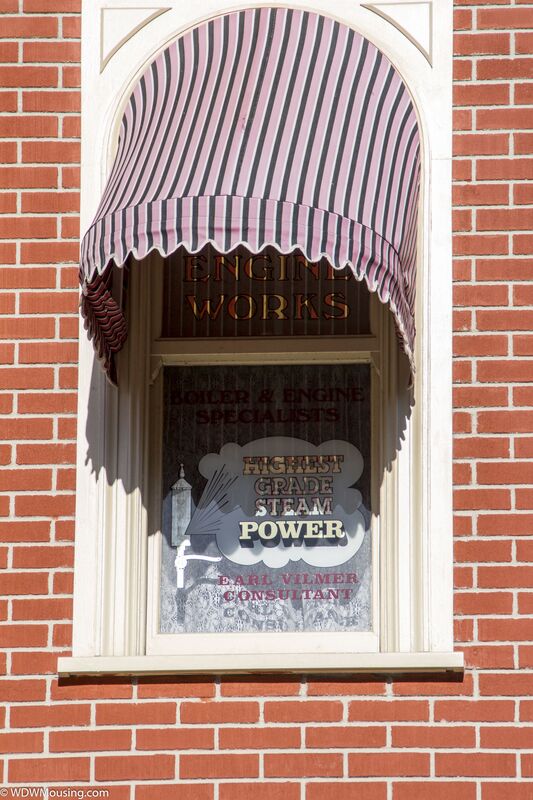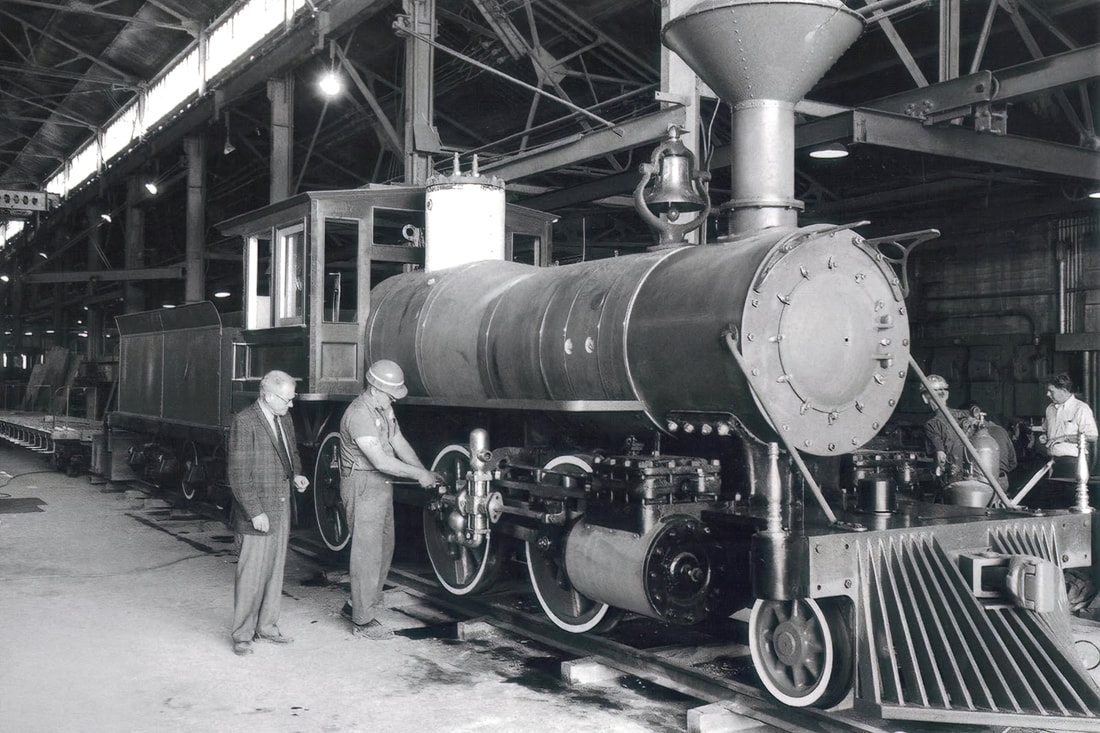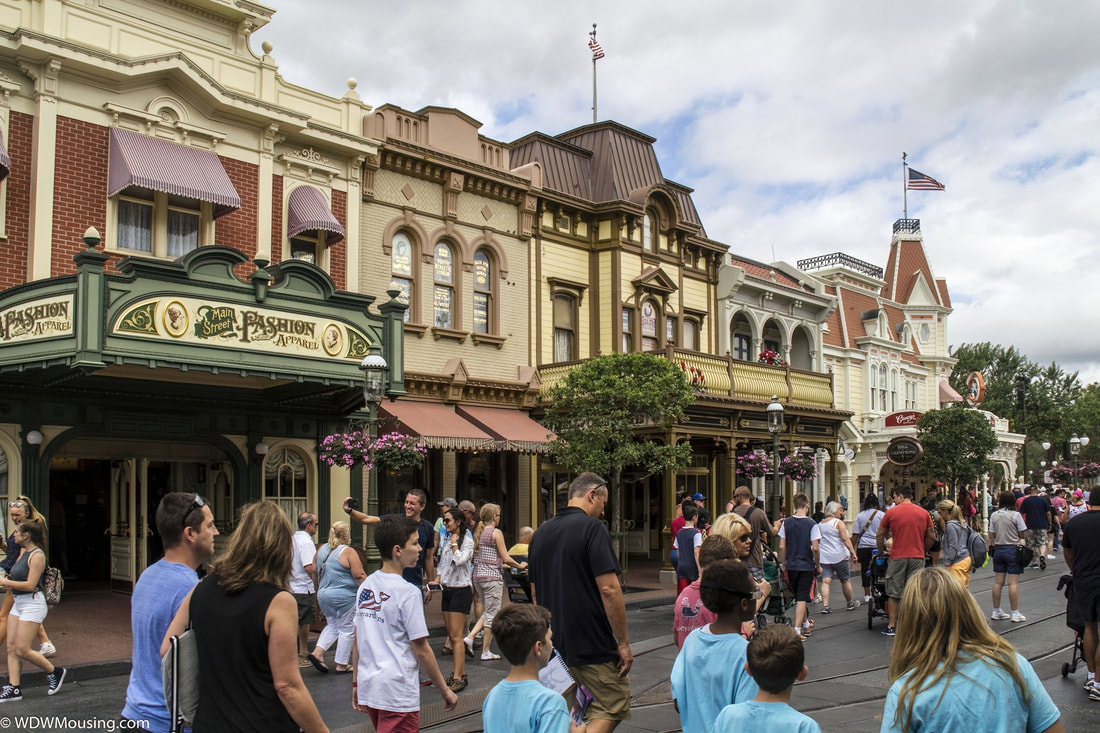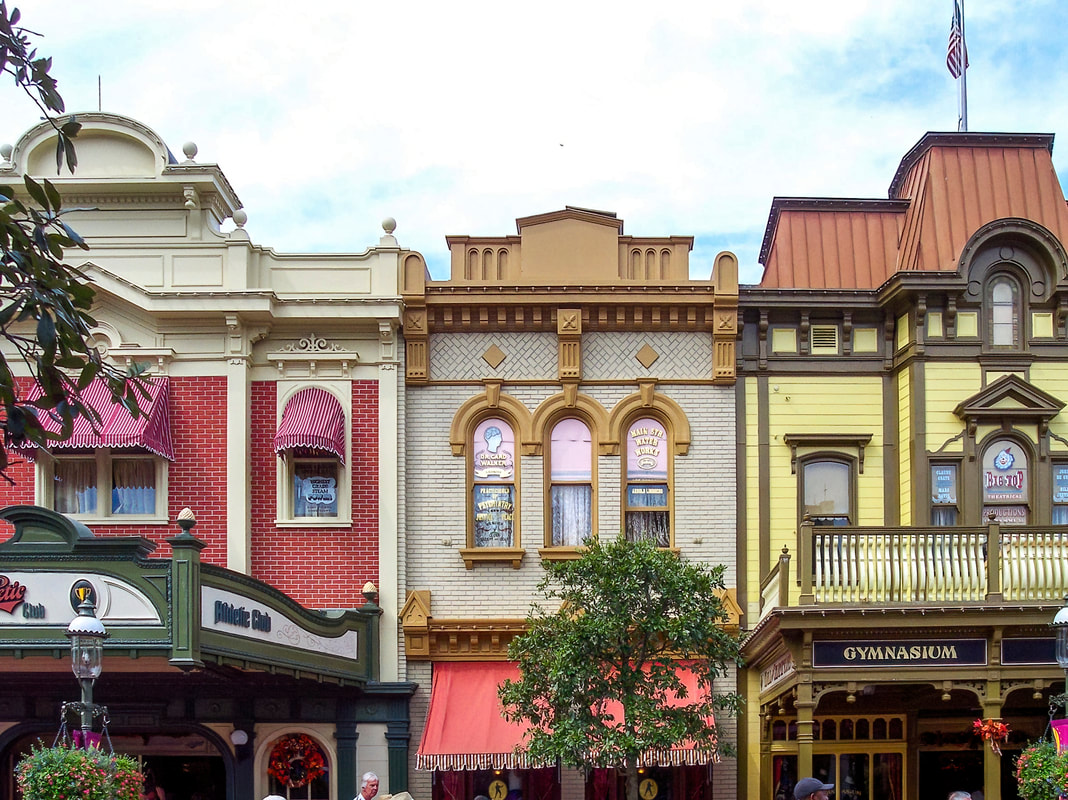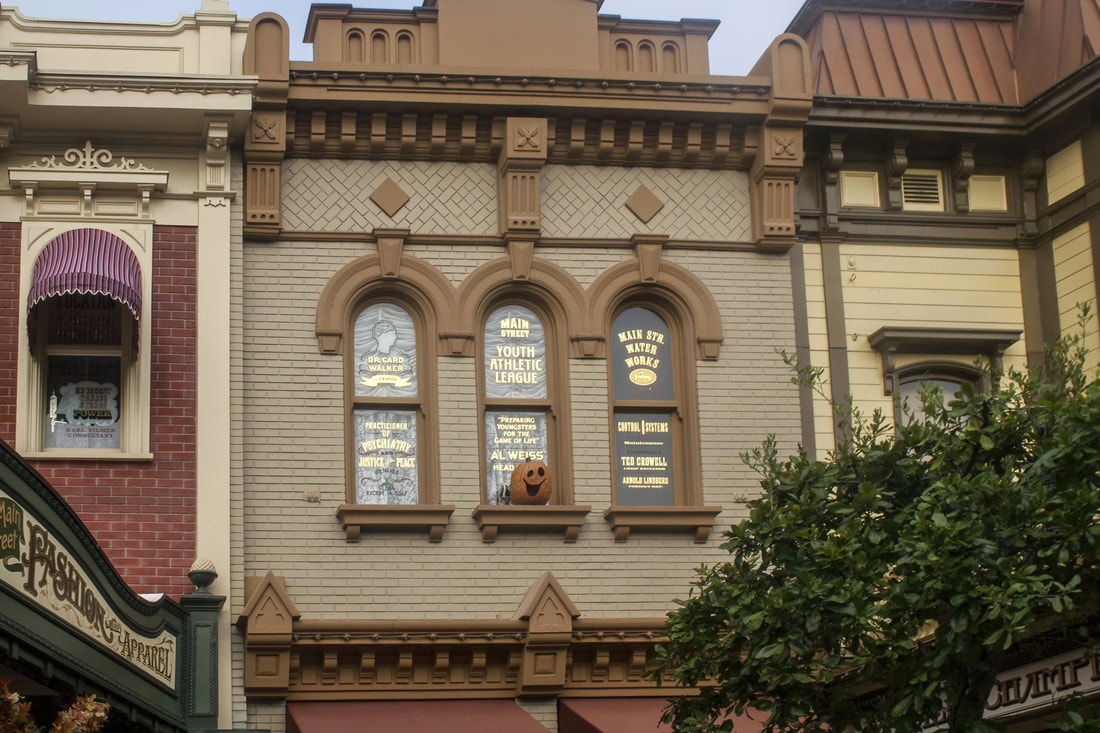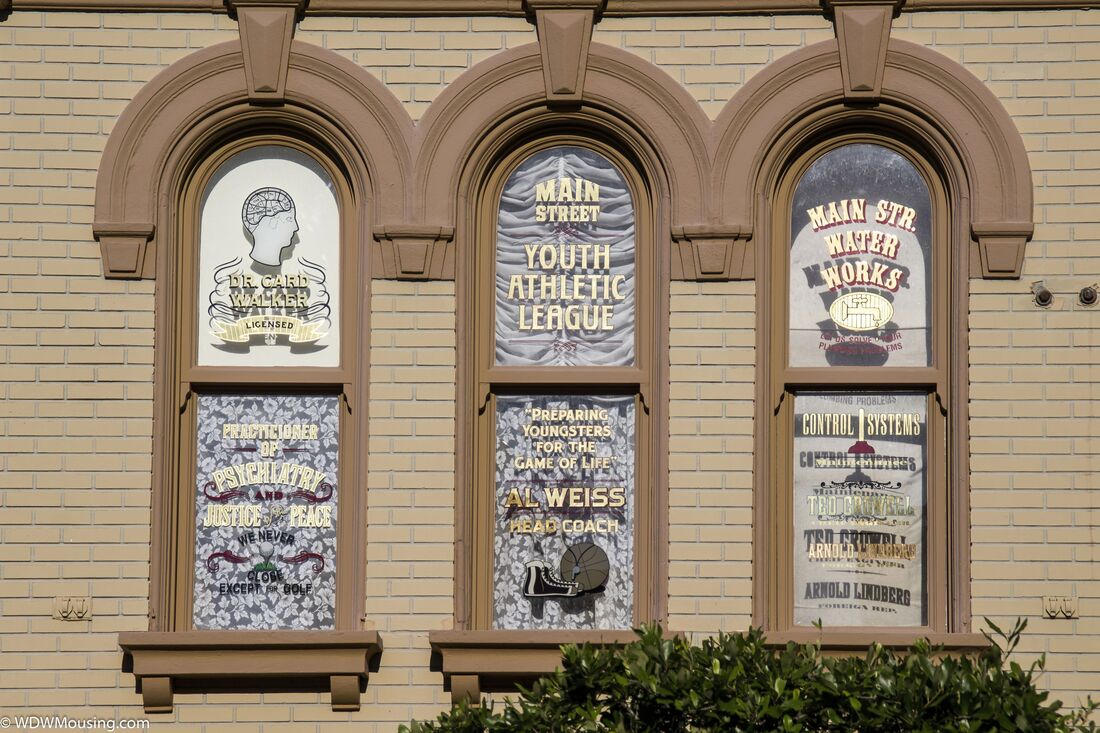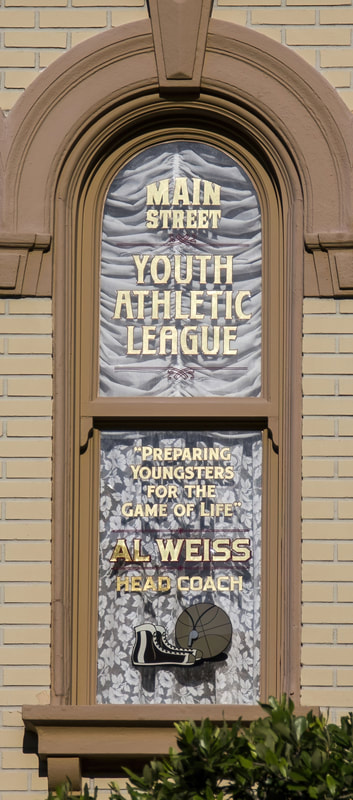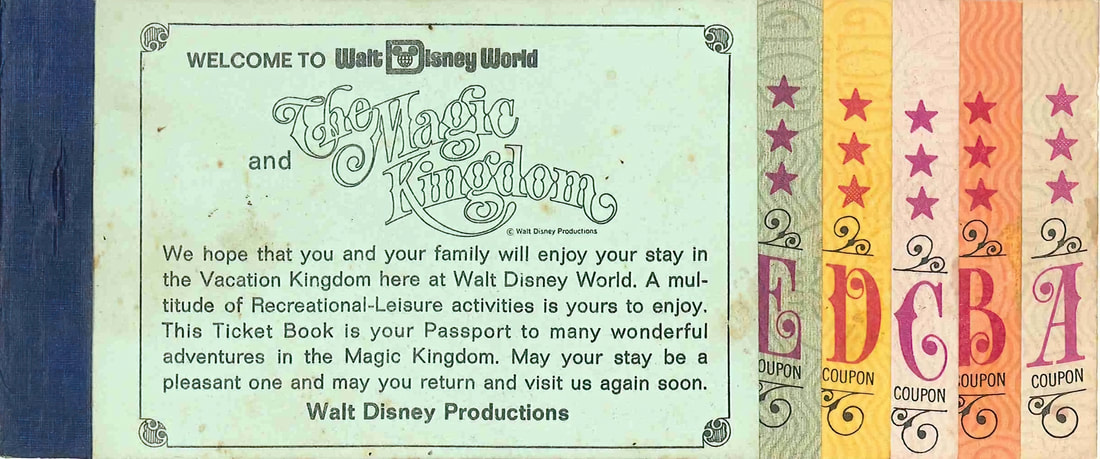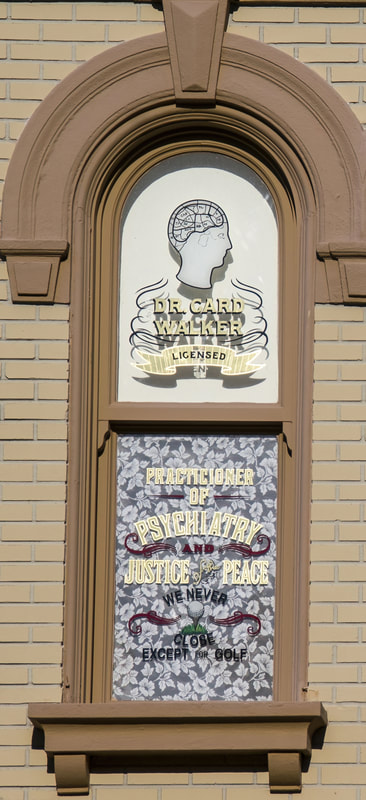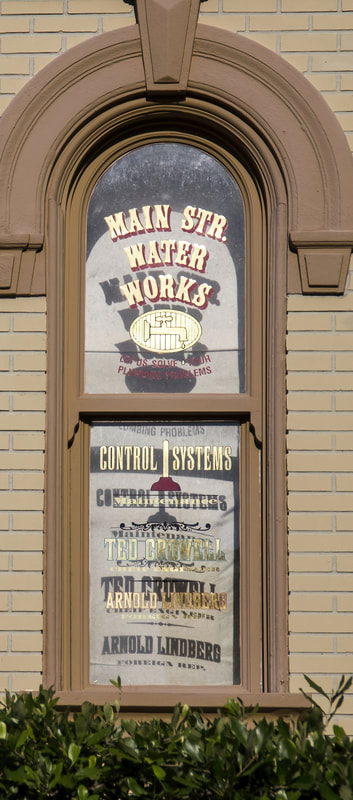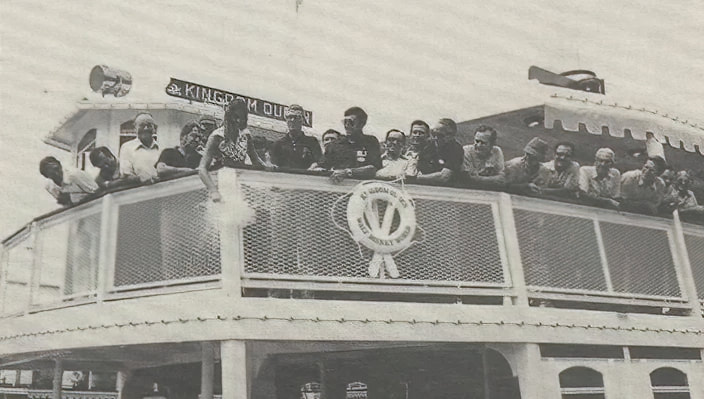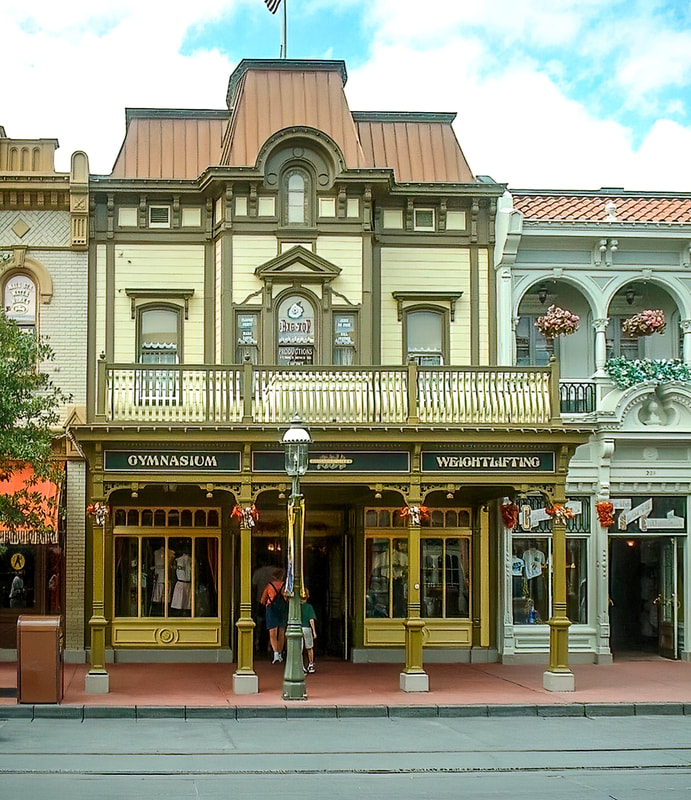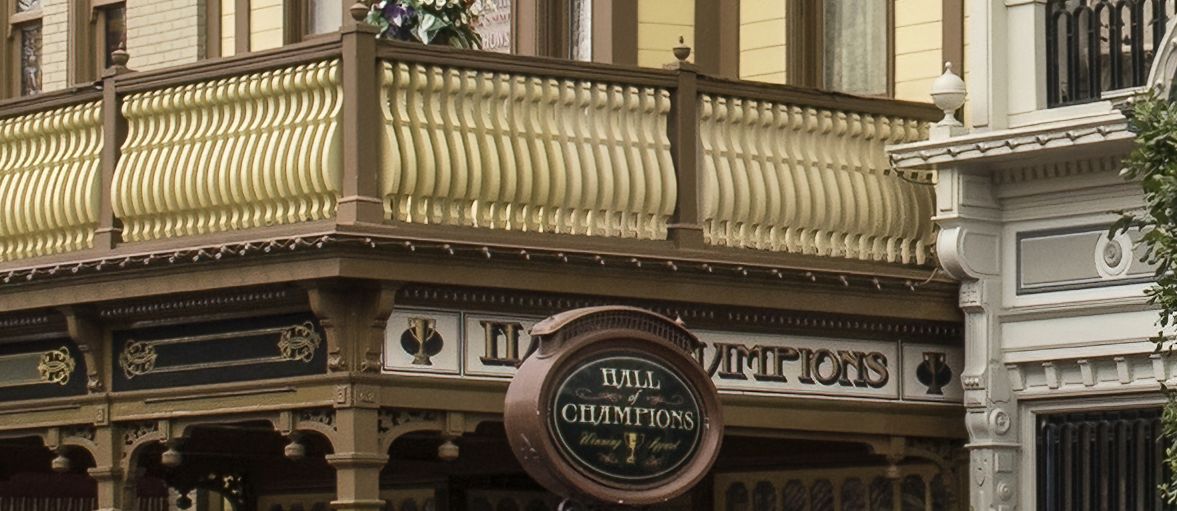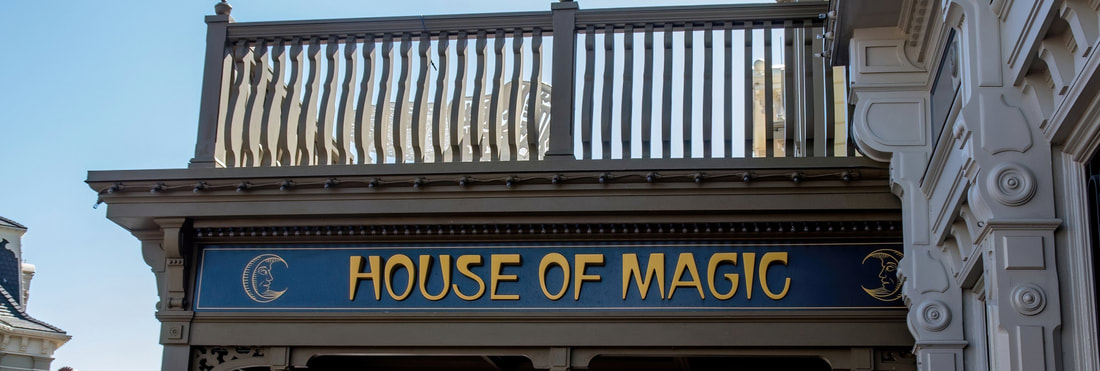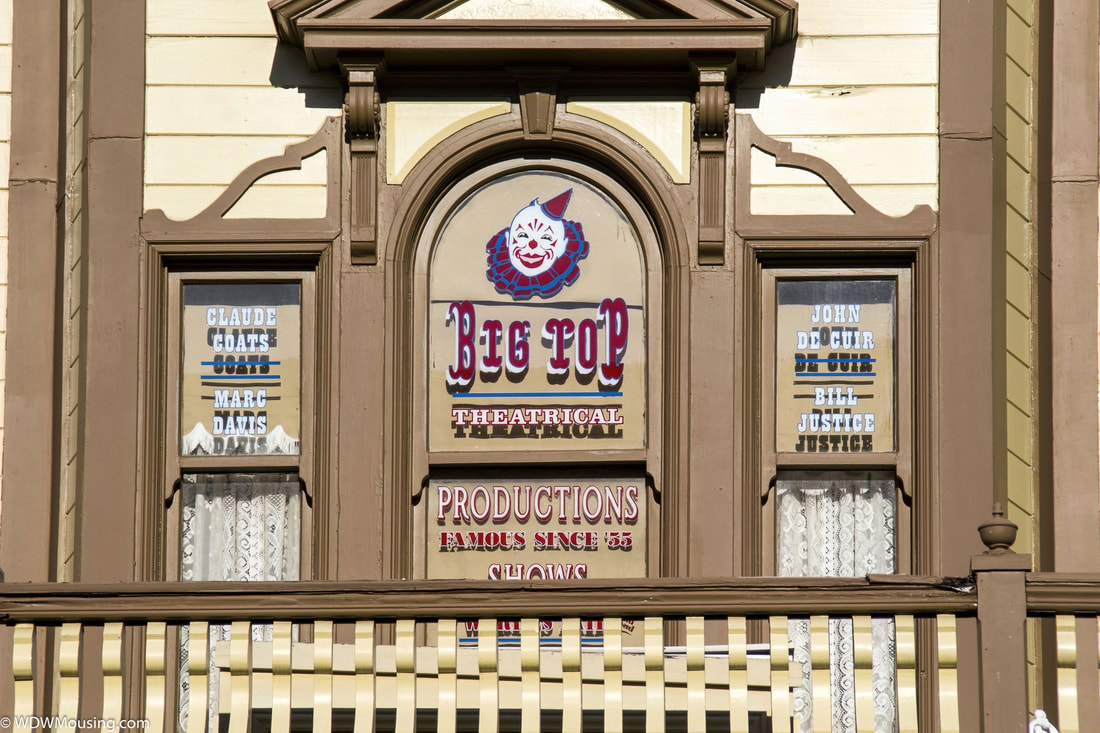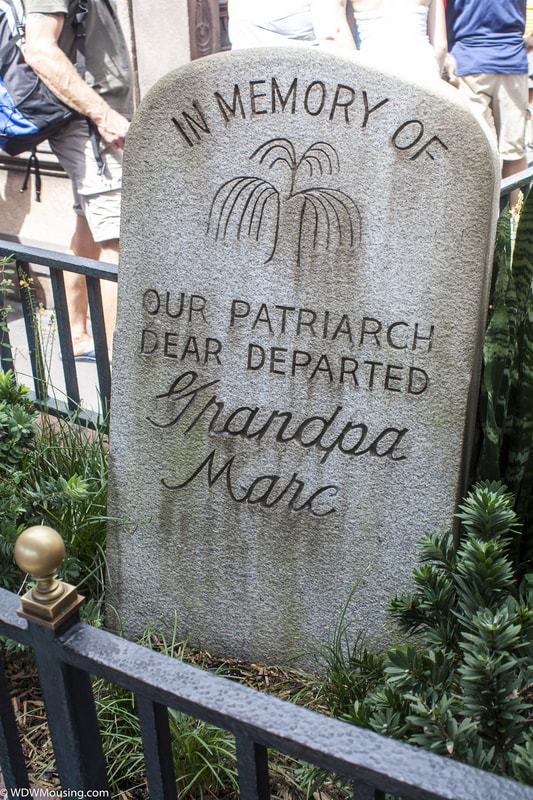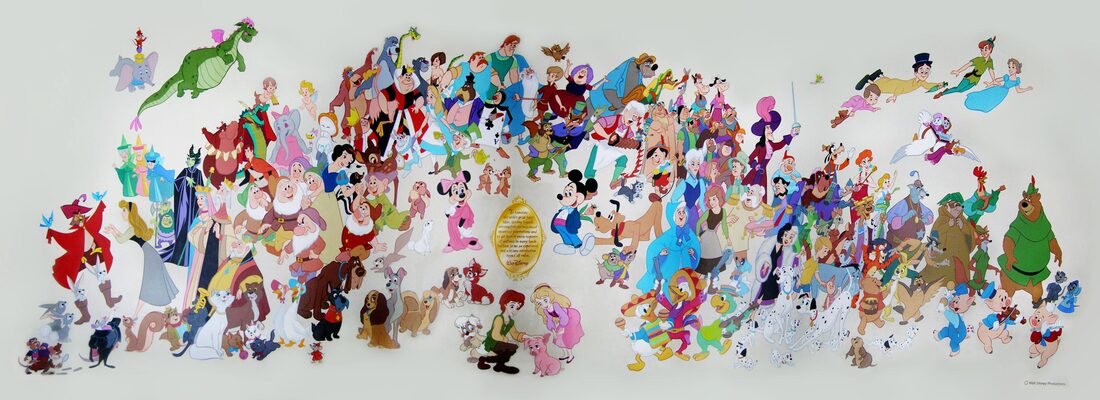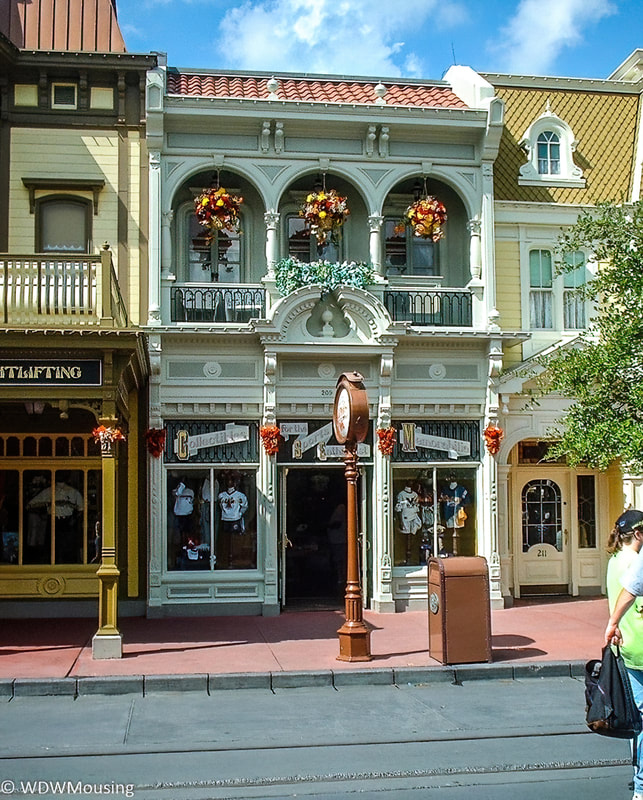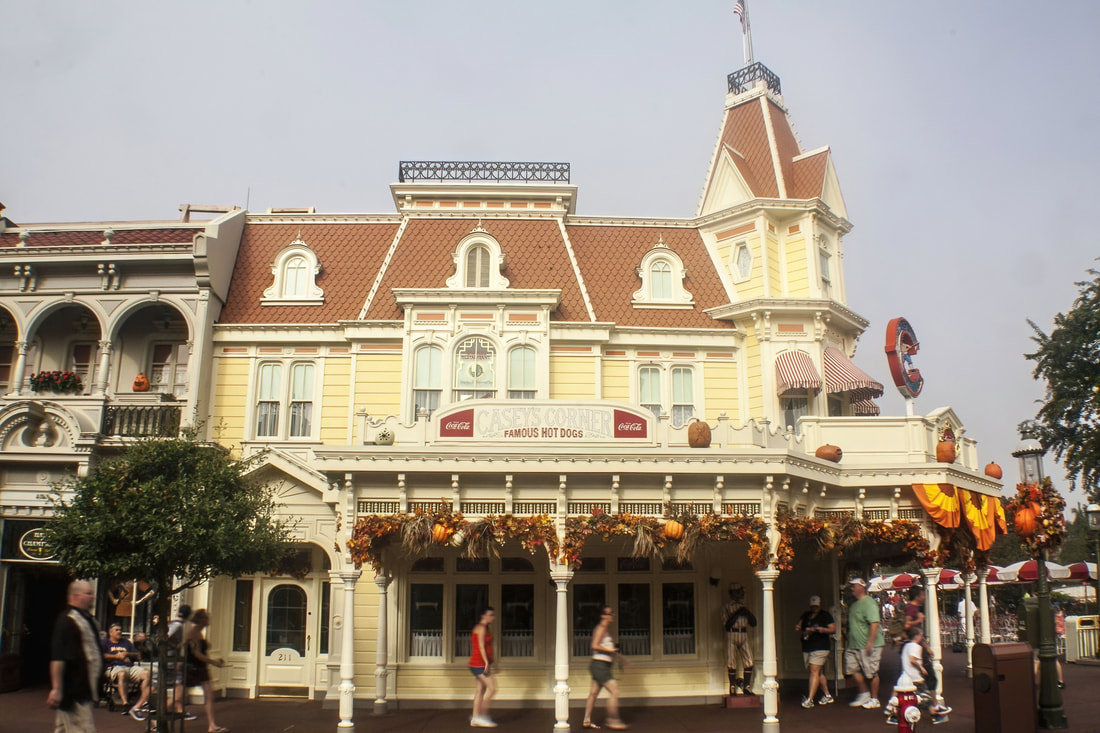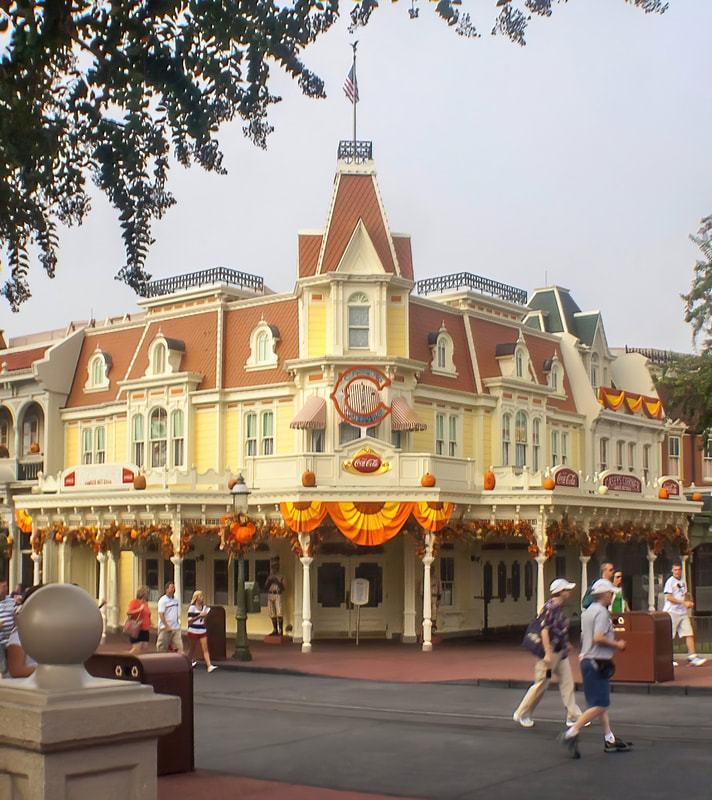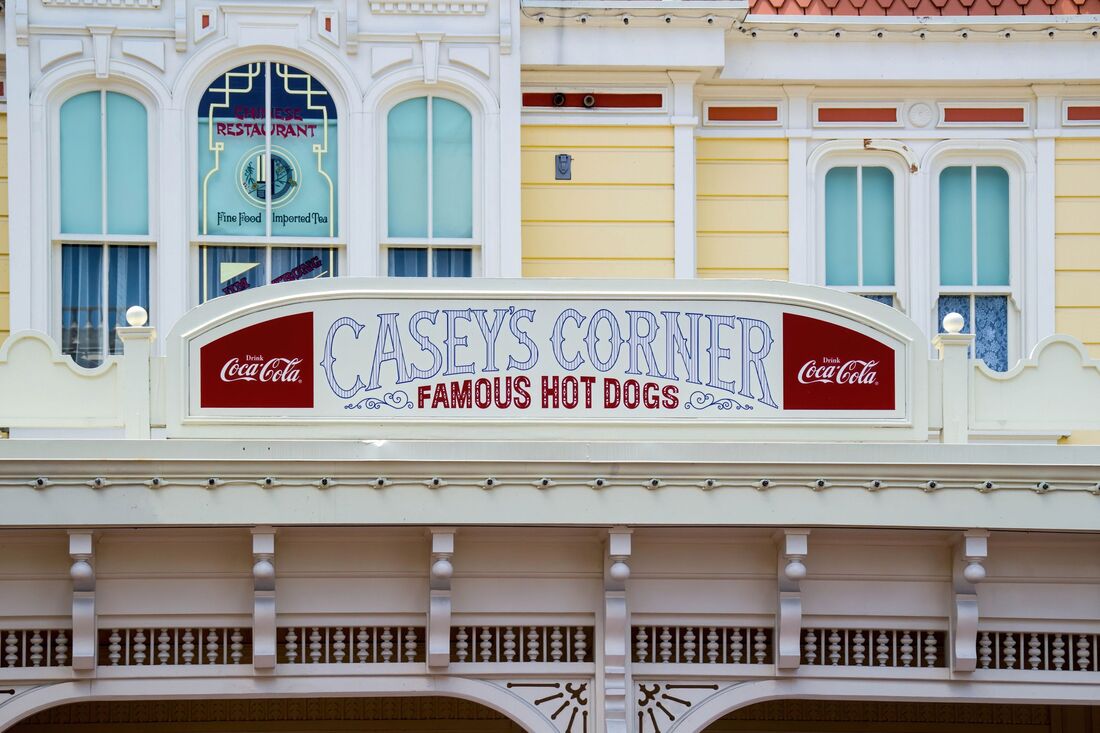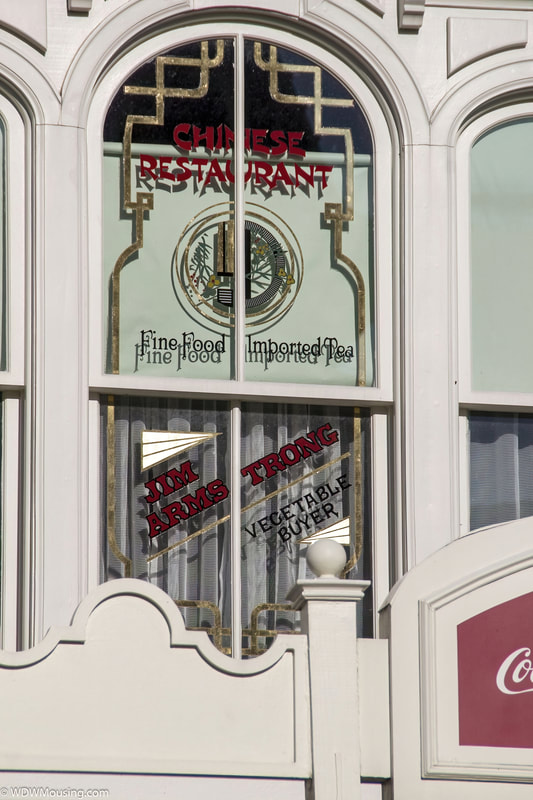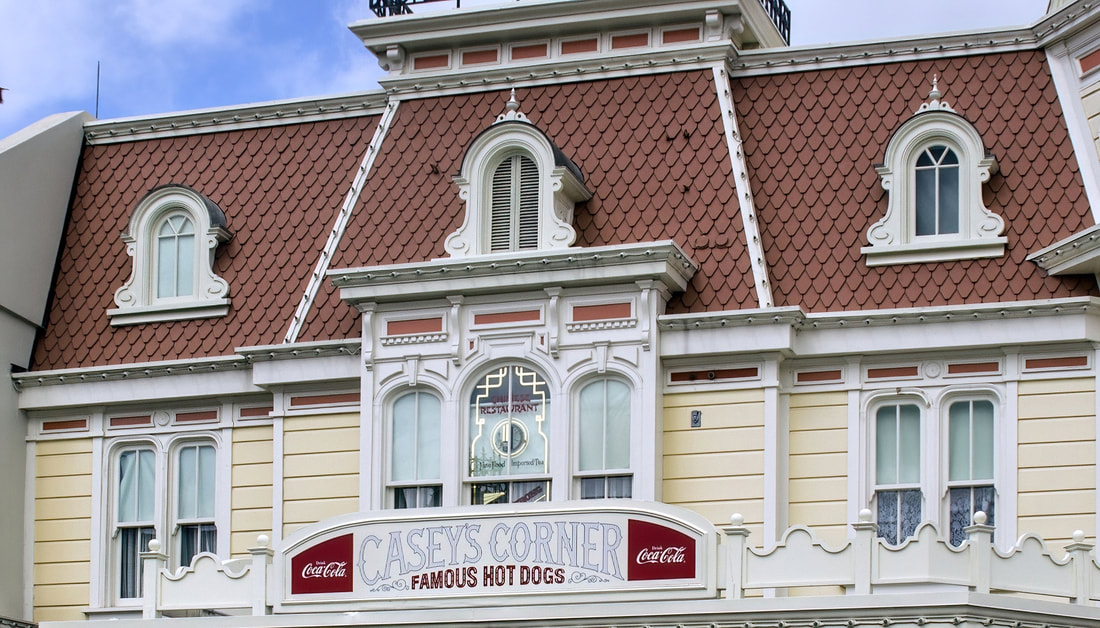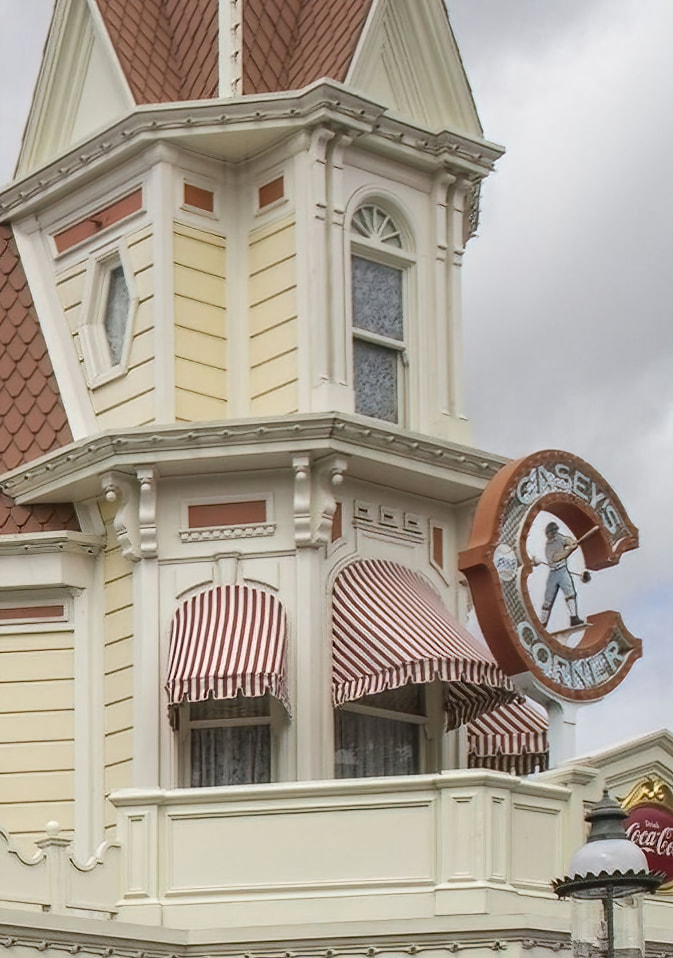Chapter 39 - Magic Kingdom - Windows on Main St. USA - West Side Main St. - Part 4 posted Jan 2022
We return to the West side of Main S. U.S.A and check out the windows going up the Street.
This is the fourth installment of our tour of the Windows on Main St. U.S.A. We’re going to restart at the beginning of Main St and view the Windows on the west side basically those over the Emporium.
The Emporium has many different store fronts (Façades) and over the years several were actually different shops. (See Magic Kingdom Chapter 6 – for the Emporium history).
The Emporium has many different store fronts (Façades) and over the years several were actually different shops. (See Magic Kingdom Chapter 6 – for the Emporium history).
|
A look down the left side of Main St. U.S.A
|
Main entrance to the Emporium on the corner of Town Square and Main St.
|
The next store front is a grey brick facade.
Emile won two Academy Awards for set decoration, the first for William Wyler's 1949 film, ''The Heiress,'' the second for Disney's ''20,000 Leagues Under the Sea'' in 1954. During his career he received a total of eight Oscar nominations. These include his work on the Disney films Mary Poppins, Bedknobs & Broomsticks, and The Absent- Minded Professor.
Emile was the chief interior and exterior decorator for Walt Disney World and Disneyland, as well as company executive offices, following his set decoration experience at the Walt Disney Studios.
Emile Kuri got his first film job from the director Hal Roach, to help design the set for his 1937 comedy, ''Topper.'' He went on to work with Alfred Hitchcock on the sets for ''Spellbound,'' ''Rope'' and ''The Trouble With Harry'' and on George Stevens's ''Shane'' and ''Place in the Sun.''
Emile was the chief interior and exterior decorator for Walt Disney World and Disneyland, as well as company executive offices, following his set decoration experience at the Walt Disney Studios.
Emile Kuri got his first film job from the director Hal Roach, to help design the set for his 1937 comedy, ''Topper.'' He went on to work with Alfred Hitchcock on the sets for ''Spellbound,'' ''Rope'' and ''The Trouble With Harry'' and on George Stevens's ''Shane'' and ''Place in the Sun.''
Resource:
https://en.wikipedia.org/wiki/Emile_Kuri
https://d23.com/a-to-z/kuri-emile/
https://www.nytimes.com/2000/10/14/arts/emile-kuri-93-set-decorator-for-movies-and-disney-world.html
https://www.mouseplanet.com/7095/Windows_on_Main_Street_Part_1
https://en.wikipedia.org/wiki/Emile_Kuri
https://d23.com/a-to-z/kuri-emile/
https://www.nytimes.com/2000/10/14/arts/emile-kuri-93-set-decorator-for-movies-and-disney-world.html
https://www.mouseplanet.com/7095/Windows_on_Main_Street_Part_1
A quick look up at the third floor windows show that there is just a light in the window, but no one is home.
The next building is a red brick faced store front. Inside is still the continuation of the Emporium.
The next building is called the Arcade, this is not the original location of the arcade games from October 1971 to March 1995, that was located further up the West side of Main St., but closed when the Emporium was expanded. Only the sign survived as a reminder of some of Main St’s history. (Read more in Magic Kingdom Chapter 6 Main St. U.S.A. West Side)
Second floor Middle Window hold a tribute for,
Charles Ridgway - began his career writing and editing news for radio and newspapers. In 1963 Charlie joined the Disneyland’s publicity office. During 1954-55, he authored some of the first articles about Disneyland to appear in any of the major metropolitan newspapers. Eight years later, he joined the Park’s publicity staff. Charlie was promoted to Disneyland’s publicity supervisor in 1966. In 1969 he was bumped up to publicity manager and, later, director of press and publicity
He was involved in the launch of Magic Kingdom in 1971, Epcot Center in 1982, and Euro Disneyland in 1992. He also helped launch Disneyland Paris in 1992, as well as special projects for celebrations such as Donald Duck’s 50th birthday.
He was involved in the launch of Magic Kingdom in 1971, Epcot Center in 1982, and Euro Disneyland in 1992. He also helped launch Disneyland Paris in 1992, as well as special projects for celebrations such as Donald Duck’s 50th birthday.
|
After Charlie Ridgway retired, he went on to consult on special projects, including the launch of Disney’s Animal Kingdom and the Disney Cruise Line. Charles published his memoir, “Spinning Disney’s World,” in 2007. Ridgway is known for his extensive participation with media coverage during the opening of Magic Kingdom back in 1971 including the iconic LIFE Magazine cover showing nearly 3,000 Cast Members in front of Cinderella Castle. |
References:
As we move up the street, the next facade is, this was the former end to the Emporium. The exit led to the West Center Street (to see more about the former West Center Street go to Chapter 6 - Magic Kingdom - Main St USA West) that was lost forever in 2001 due to the Emporium expansion.
The first window on the second floor is a relatively small window. But the Imagineer attributed did not have a small role in developing Disneyland and Walt Disney World.
|
Dolls by Miss Joyce Dollmaker for the World Shops in New York, California, Florida, Japan & Paris Owner and Founder Joyce Carlson Joyce Carlson - was the first Cast Member to not only achieve 50+years status, with the company, Joyce started her career with Disney in 1944 in the “traffic” department… delivering pens, pencils, paints, and brushes to Disney animators.
She then joined the Ink and Paint department painting and inking such classics as The Three Caballeros, Cinderella, Peter Pan, Sleeping Beauty, and many others. In 1960, Joyce utilized her talents and joined WED Enterprises. She worked alongside Mary Blair and Marc Davis creating miniature prototypes for the 1964 World’s Fair including the dolls for it’s a small world. She worked on every one of the it’s a small world attractions from Florida to Tokyo. At Walt Disney World, Joyce maintained many other attractions and their Audio-Animatronics characters including the Carousel of Progress. |
Not only is there a tribute to Joyce on a window above the Emporium, but her face can be seen inside
In the lower corner of the mural behind the central checkout counter of the Emporium.
In the lower corner of the mural behind the central checkout counter of the Emporium.
Also, in the “it’s a small world” attraction, there is a doll at the bottom of the Eiffel Tower that carries a facial likeness of Joyce. (See Chapter 20 – Fantasyland – “it’s a small world”)
Sources:
Sources:
The next pair of windows honors the MAPO Group. MAPO is the acronym for Manufacturing and Production Organization. Which were the Imagineers responsible for many of Disney’s attractions.
In this group of windows:
In this group of windows:
Bob Booth - Bob joined Disney in 1957 as a precision machinist and worked in the Studio’s Camera Service department Roger Broggie Sr. made Bob supervisor of the Studio Machine Shop.
In 1965, Booth set up the innovative new multi-craft research and development and manufacturing subsidiary for Walt Disney Productions, known as MAPO
Booth was the guy leading all the productions at MAPO. If it wasn’t for him and others many of the attractions that became part of Walt Disney World and ones that followed after opening (and will come to fruition) would never become reality.
Booth supervised the design and construction of an all-new state-of-the-art building adjacent to the headquarters of WED Enterprises, now Walt Disney Imagineering.
For the next 20 years Bob played a major role in all phases of manufacturing for Disney Parks around the world. “Bob was Broggie’s main man on the shop floor, leading all the production departments at MAPO,"
In 1965, Booth set up the innovative new multi-craft research and development and manufacturing subsidiary for Walt Disney Productions, known as MAPO
Booth was the guy leading all the productions at MAPO. If it wasn’t for him and others many of the attractions that became part of Walt Disney World and ones that followed after opening (and will come to fruition) would never become reality.
Booth supervised the design and construction of an all-new state-of-the-art building adjacent to the headquarters of WED Enterprises, now Walt Disney Imagineering.
For the next 20 years Bob played a major role in all phases of manufacturing for Disney Parks around the world. “Bob was Broggie’s main man on the shop floor, leading all the production departments at MAPO,"
# # #
|
Roger Broggie Jr., - was the son of Disney Legend Roger Broggie Sr. Roger Jr. began working for Walt as a boy in 1950 when he tended Disney's backyard railway the Carolwood Pacific at Walt’s Holmby Hills home.
At 18, Roger Broggie Jr. joined Disney’s company as an apprentice in the machine shop managed by his father. He helped to build several Disney attractions for the 1964 New York’s World Fair, were Broggie Jr. became known for his hands-on technical wizardry and helping to create the form of Disney robotics known as audio-animatronics. Roger Jr. became an audio-animatronics pioneer, making major contributions to such attractions as the Lincoln figure for the ’64 World’s Fair, Walt Disney World’s Country Bear Jamboree, the Enchanted Tiki Room, Pirates of the Caribbean and the Haunted Mansion. When Disney made the 1969 film “The Love Bug,” the junior Broggie’s mechanical fascination with cars helped him build 17 Volkswagens that brought Herbie the Love Bug to life on the big screen. Each car was made to do a different trick, such as flying or floating. Between 1973 and 1975, Broggie worked on the EPCOT Center project at Walt Disney World Resort in Florida. # # #
|
John Franke - was a member of the MAPO team. Among John’s many contributions was leading the project that built the Tiki Birds and the Walt Disney’s Enchanted Tiki Room attractions. This was the first time anything like this had ever been attempted. In 1966, after Walt Disney passed away the E.P.C.O.T project’s centerpiece, the model, was unfinished. After Walt’s death the EPCOT city project was abandoned. But it was decided that the model should be completed anyway, by a team led by Johnny Franke. Members of the team included Roger Broggie, Jr., Yale Gracey, George Windrum, and many others. # # #
|
Neil Gallagher - Neil hired into the Disney Studio machine shop in April 1957. He worked on developing and manufacturing of the mechanical animation needed for Walt Disney’s Enchanted Tiki Room. Neil built the flower boats with singing orchids, tiki drummers and rotating birdcages.
Neil’s help in working on the Lincoln figure for the New York World’s Fair. Neil also led the show and animation maintenance of all four of Walt’s World’s Fair Showcase presentations. He then returned to California and led show and animation teams at MAPO in the development of new shows and attractions for Disneyland and Walt Disney World in Florida.
Shortly after the Walt Disney World resort’s opening, Neil as promoted to Director of Maintenance for Walt Disney World. He continued to be promoted throughout his career as he helped with the opening of Epcot, Tokyo Disneyland, Disney’s Hollywood Studios, and Euro Disney (Disneyland Paris). Neil retired as Walt Disney World’s Vice President of Engineering, Construction and Central Shops.
Neil’s help in working on the Lincoln figure for the New York World’s Fair. Neil also led the show and animation maintenance of all four of Walt’s World’s Fair Showcase presentations. He then returned to California and led show and animation teams at MAPO in the development of new shows and attractions for Disneyland and Walt Disney World in Florida.
Shortly after the Walt Disney World resort’s opening, Neil as promoted to Director of Maintenance for Walt Disney World. He continued to be promoted throughout his career as he helped with the opening of Epcot, Tokyo Disneyland, Disney’s Hollywood Studios, and Euro Disney (Disneyland Paris). Neil retired as Walt Disney World’s Vice President of Engineering, Construction and Central Shops.
# # #
Rudy Pena – still researching. Rudy was a mechanical engineer with MAPO.
# # #
Dave Schweninger - was responsible for many of the design and implementation of many aspects of Disney’s Audio-Animatronics for various attractions in both parks. One of his bigger projects was that of the Haunted Mansion’s Audio-Animatronic figures, and animation. He also ran the animation shop at MAPO. In the late ’60s, David worked closely with Marc Davis to bring his characters to mechanical life. Schweninger was involved with the development of many of the animatronic and mechanical effects found in both the Disneyland and Walt Disney World Haunted Mansions.
# # #
Dick Van Every - There is not a lot of information on Dick other than he was a mechanical engineer with MAPO.
# # #
Jim Verity Also worked on a number of projects in the Audio-Animatronics department. Jim participated in the development of the first generation of audio-animatronic figures, which he helped to install at the 1964 New York World's Fair. Through the years, Jim worked in Engineering Services, Show Quality Control, and in construction of some of the largest projects, including Epcot Center.
Reference:
- https://d23.com/walt-disney-legend/bob-booth/
- https://www.latimes.com/local/obituaries/la-xpm-2013-jan-15-la-me-roger-broggie-20130116-story.html
- https://en.wikipedia.org/wiki/Roger_E._Broggie
- http://www.wdwforgrownups.com/articles/profile-imagineer-roger-broggie-jr
- https://www.scpr.org/programs/take-two/2013/06/28/32482/disneyland-s-enchanted-tiki-room-turns-50/
- https://sites.google.com/site/theoriginalepcot/progress-city-model/model-overview
- https://d23.com/walt-disney-legend/neil-gallagher/
- http://www.hauntedmansion.com/insiders_schweninger.php
- http://disneylegends.blogspot.com/2018/06/dave-my-295th-pick-to-be-named-disney.html
- https://www.legacy.com/us/obituaries/orlandosentinel/name/jim-verity-obituary?n=jim-verity&pid=126302751
- https://www.mouseplanet.com/7095/Windows_on_Main_Street_Part_1
- http://doombuggies.com/
- https://www.insider.com/vintage-disneyland-behind-the-scenes-photos-2019-10#many-disneyland-attractions-started-off-as-unrecognizable-inventions-10
The next set of windows have no tributes or dedications.
We’ve reached the Emporium mid-point. As we mentioned earlier pre-2001 this was where the former West Center St existed.
Proceeding the MAPO Imagineers windows are a series of three corner windows:
These windows are dedicated to a group of gentlemen who were Walt Disney Imagineering engineers, including project, manufacturing, mechanical, and civil engineers, that worked on the opening of the Magic Kingdom.
These windows are dedicated to a group of gentlemen who were Walt Disney Imagineering engineers, including project, manufacturing, mechanical, and civil engineers, that worked on the opening of the Magic Kingdom.
|
Associates
Morrie Houser Lou Jennings John Joyce |
Super Structures, Inc.
Engineers and Associates Don Edgren John Wise |
Associates
Ken Klug Stan Maslak John Zovich |
The first of the set:
|
Morrie House – was a Disney Imagineer since 1954, Morrie worked on – and was instrumental in – developing and bringing to fruition many of the most popular and famous attractions in both parks. One of his specialties was the Disney Railroad. At the time of his death, he was building – for the past 40 years – from scratch a scale model of Walt Disney’s Central Pacific No. 173, Lily Belle. The model is displayed at “Walt’s Barn” and there is a sign below it saying that it’s still considered “a work in progress.”
|
- Lou Jennings - Lou was an engineer with WED (Imagineering), research still in progress
- John Joyce - John was an engineer with WED (Imagineering), research still in progress
Second of the Set:
|
Don Edgren - Engineer Don Edgren worked for Wheeler & Gray, Structural Engineers which were hired by The Walt Disney Studios to work on the structural design and detail of Disneyland from late 1954 until the Park opened in July 1955. Don figured out how to create of the complex structure for the Matterhorn, where many of engineers said that it was impossible. Don also worked on the New York World’s Fair project as a project engineer on the Ford Motor Company exhibit.
Pirates of the Caribbean was originally supposed to be a walk-through attraction, but when Walt decided it would be a dark boat ride it was Don and his engineer’s responsibility to figure out how to make the attraction deeper to accommodate the ride system.
Don was involved in the initial master planning for Walt Disney World in Florida. In 1969, he was promoted to vice president – engineering and was head of the field engineering. He also led his team on creating the first Space Mountain at Walt Disney World. Don was the director of engineering for Tokyo Disneyland. From 1983 until his retirement in 1987, Don was responsible for the direction and supervision of all project engineers. |
John Wise - John was assigned to the Disneyland Construction project as structural engineer with Wheeler & Gray. Wise designed the simple modular support structures used for many of the buildings on Main Street and elsewhere in Disneyland. The simple supports gave the buildings the necessary support and structure, allowing Disneyland's art directors to create artistic, non-structural facades.
In 1957, John joined The Walt Disney Studios as a Chief Engineer in WED Enterprises (later known as Imagineering). In 1969 Wise was named Vice President of Engineering for WED Enterprises in California. Working with Don Edgren, Wise helped coordinate engineering design & planning during Walt Disney World's construction, beginning in the late 1960's, through the resort's opening on October 1, 1971.
In 1957, John joined The Walt Disney Studios as a Chief Engineer in WED Enterprises (later known as Imagineering). In 1969 Wise was named Vice President of Engineering for WED Enterprises in California. Working with Don Edgren, Wise helped coordinate engineering design & planning during Walt Disney World's construction, beginning in the late 1960's, through the resort's opening on October 1, 1971.
The Third Window in the Set:
|
Ken Klug - Ken was an Imagineer who started his career in 1962 working at WED in Disneyland and contributed greatly to the creation of Walt Disney World in Florida. He was responsible for all the civil aspects for new attractions at Walt Disney World in Florida. Within four years, he was promoted to Chief of Civil Engineering, where he planned and orchestrated the massive site and infrastructure development of 27,000 acres of grazing and swampland that would become the Walt Disney World Complex in Florida.
Stan Maslak - Stan was an Imagineer who among other projects was the project engineer for the Railway Station at Walt Disney World’s Main Street U.S.A. |
John Zovich - John was one of Don Edgren’s chief protégées (see above) and not only instrumental in the design and construction of Walt Disney World. He was the man who puts all the pieces together from designs created by the Imagineers. John was the Vice President of Engineering of Epcot. All engineering at WED was under the direction of John Zovich. John was over both MAPO and a separate facility.
Info:
Info:
As you turn the corner, to the left of the middle of Main St’s entrance to the Emporium, are two sets of windows.
The left set of windows has a tribute to:
Resource:
The second Set:

In 1950 Walt asked Bill to write for television. Bill went on to produce the Mickey Mouse Club and the Davy Crockett television mini-series, among others. He then switched to live-action features either as a writer, co-producer or full producer. Among his most famous (and popular) were The Shaggy Dog, The Absent-Minded Professor, Son of Flubber, That Darn Cat! The Love Bug, Bedknobs and Broomsticks, and of course Mary Poppins.
One of the reasons why Bill has a window at Walt Disney World is because the profits from Mary Poppins made purchasing all the land for Walt Disney World possible.
After Walt Disney's death in 1966, Walsh was part of the seven-man committee who ran the company. In 1970, an article in Variety magazine listed him as the second most successful film producer of all time in terms of money-earning movies.
One of the reasons why Bill has a window at Walt Disney World is because the profits from Mary Poppins made purchasing all the land for Walt Disney World possible.
After Walt Disney's death in 1966, Walsh was part of the seven-man committee who ran the company. In 1970, an article in Variety magazine listed him as the second most successful film producer of all time in terms of money-earning movies.
Additional:
We’ve reached the center of the West Side of Main St. U.S.A., which is also the middle of the Emporium.
The Windows above the entrance are attributed to the Emporium
|
Electrical Lamps Graphophone Talking Machines Edison Kinetoscopes Imported Glassware |
Emporium
Offerings The Latest And Greatest |
Ladies Wearing Apparel Finest House Furnishings Children’s Toys & Novelties |
The side windows have no dedication or inscriptions.
Stuck in the corner on the other side of the Emporium alcove is a Window with a dedication to:
Robinson’s Repairs
|
Restorations
Renovations |
No job too large or too small
Cecil Robinson Proprietor |
Cecil Robinson - Cecil worked in facilities and became the vice president of Facility Services. He also for 10 years was the head of Walt Disney World Accounting.
Research:
Research:
As we proceed past the Emporium Alcove, at the corner are three windows.
All three are dedicated to Jack Lindquist:
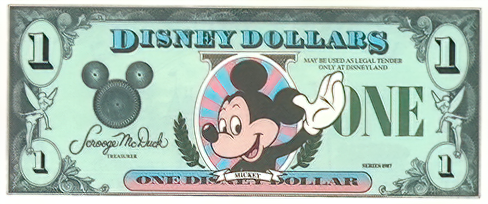
Jack Lindquist – Jack was a former child actor who appeared as an extra in the “Our Gang” series and danced in the Lucille Ball film, “Best Foot Forward,”
In 1955, Jack started as Disneyland’s first advertising manager. He continued to move through the Disney ranks and set the course for marketing Walt Disney World. In 1972, he was named vice president of marketing for Disneyland and Walt Disney World. Then, in 1976, he was named vice president of marketing for Walt Disney Attractions, and in 1982, was promoted to executive vice president of marketing and entertainment for all of the Company’s outdoor recreation activities.
Jack also set up the Marketing Division for Tokyo Disneyland, and as executive vice president of creative marketing concepts for Walt Disney Attractions he developed promotional and entertainment ideas for Disneyland, Walt Disney World, Tokyo Disneyland and Disneyland Paris.
During his years with Disney, Jack was responsible for a number of classic Disney projects including, Walt Disney’s Magic Kingdom Club, Disney Dollars, the Disneyland Pigskin Classic, the Ambassador Program and Grad Nites. He was also one of the big supporters for Disney’s California Adventure.
In 1955, Jack started as Disneyland’s first advertising manager. He continued to move through the Disney ranks and set the course for marketing Walt Disney World. In 1972, he was named vice president of marketing for Disneyland and Walt Disney World. Then, in 1976, he was named vice president of marketing for Walt Disney Attractions, and in 1982, was promoted to executive vice president of marketing and entertainment for all of the Company’s outdoor recreation activities.
Jack also set up the Marketing Division for Tokyo Disneyland, and as executive vice president of creative marketing concepts for Walt Disney Attractions he developed promotional and entertainment ideas for Disneyland, Walt Disney World, Tokyo Disneyland and Disneyland Paris.
During his years with Disney, Jack was responsible for a number of classic Disney projects including, Walt Disney’s Magic Kingdom Club, Disney Dollars, the Disneyland Pigskin Classic, the Ambassador Program and Grad Nites. He was also one of the big supporters for Disney’s California Adventure.
|
With a quick look at the upper floor windows, we see that they are waiting for future dedications. |
As we turn the corner and head up the Northwest side of Main St. U.S.A., above the Disney Clothier section of the Emporium, we’ll note three sets of windows.
Of the three Window Sets, only the Center holds dedications.
The next window in the set is dedicated to:
|
Center for Leadership Development & Mentoring Meg Gilbert Crofton “We start leaders on their journeys” Meg Gilbert Crofton - holds one of the newer windows on Main Street added in 2015. She started as a Marketing Manager in 1977 for a telecommunications subsidiary company that provided services to the resort. In 1984 she became the Manager of what would become Shades of Green and then was appointed vice president of human resources, then Executive VP of HR in 2002.
In 2013, Meg Gilbert Crofton made history as the first female president of Disney’s Parks and Resorts Division, a job that made her responsible for the Walt Disney World Resort, Disneyland Resort and Disneyland Paris. Research:
|
The third-floor windows are also currently empty.
As we look down the Street to the next building with the Fashion Apparel Marque,
We see there are three sets of windows over the Marque. The Marque has seen some changes over the years.
Only the two outer windows on the second floor have tributes.
|
The Big Wheel Co. “One-of-a-Kind” Unicycles Horseless Carriages Dave Gengenbach Bob Gurr George McGinnis Bill Watkins 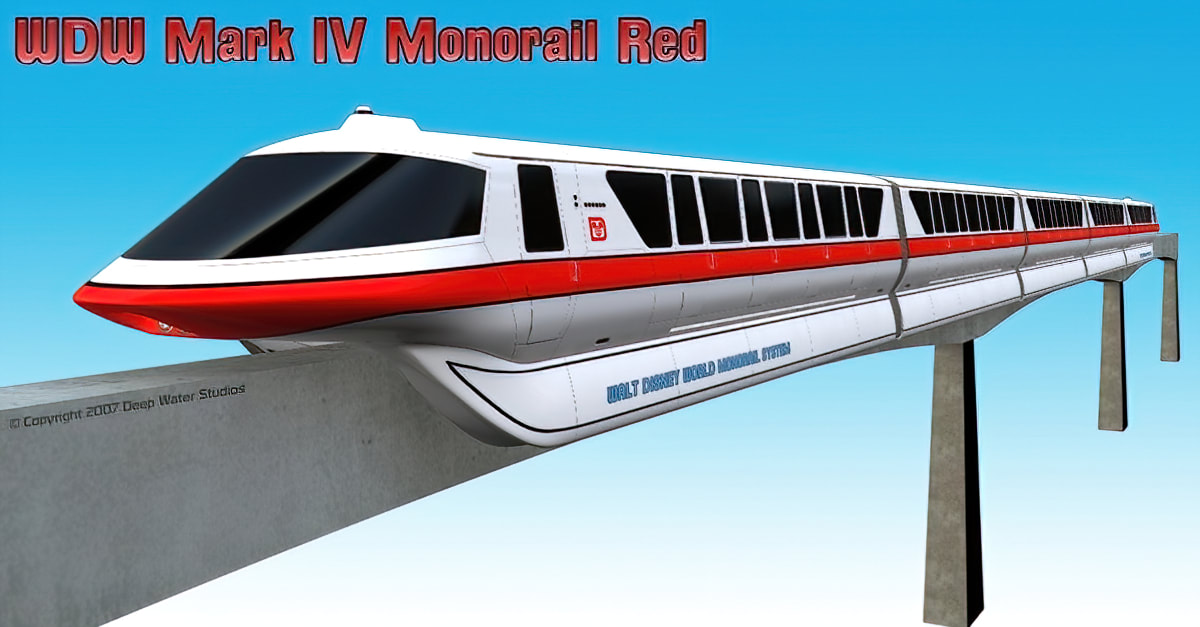
Dave Gengenbach - started working for The Disney Company in 1966 as a project manager and project engineer and worked his way up to vice president of WED Enterprises. He oversaw the design of some of Walt Disney World’s most popular rides including the Pirates of the Caribbean boat conveyance system, the design and installation of Space Mountain, and worked on the 20,000 Leagues Under the Sea attraction.
His handiwork was also seen in the designs of the Mark III (1969 – 1987) and Mark IV monorail (1971 – 1991) systems. In addition to his Main Street window, Dave is also honored with a tombstone outside the Haunted Mansion. (See Magic Kingdom Chapter 17 – Hunted Mansion Queue) Bob Gurr - has some impressive numbers – for nearly 40 years he has developed more than 100 vehicle and ride conveyance designs for various attractions. Bob worked transportation magic developing the memorable Flying Saucers attraction in Tomorrowland, the antique cars and double-decker buses of Main Street, U.S.A., Ford Motor Company’s Magic Skyway, which premiered at the 1964-65 New York World’s Fair, and more. Bob also helped design the mechanical workings of Disney’s first Audio-Animatronics® human figure, Abraham Lincoln, featured in Great Moments with Mr. Lincoln. Bob gave himself the title of Director of Special Vehicle Development.
One of Bob’s first big jobs was to consult with the Walt Disney Studios on the design of mini cars for a project called Autopia. Walt was so impressed with Bob’s work that he hired him full time. |

George McGinnis - who was an industrial designer. In 1966, he got Walt Disney’s attention with his project at Art Center College of Design, which was a working model of a futuristic high-speed train. Walt then showed George his “WEDway PeopleMover” system – still in development. After an introduction to Dick Irvine, President of Imagineering, George became an Imagineer.
In 1967, George’s first assignment was to design miniature transportation models for the Progress City display. He went on to design numerous design components for some of the most popular attractions including: the concept design for Space Mountain at Disneyland, prepared the conceptual layout for Space Mountain at Walt Disney World including show spaces, queue and lifts, provided detailed show elements of House of the Future for RCA, adapted the film version of 20,000 Leagues Under the Sea submarine for the attraction at Walt Disney World, as well as developed a new Peoplemover design for Walt Disney World, and designed the parking lot shuttle vehicles for Florida.
During the Epcot planning stages, George was responsible for interviewing, hiring and training a team of new designers to handle numerous design projects throughout EPCOT Center, as it was known then.
He developed the earliest concepts for the Horizons Pavilion including the multiple screen Omnimax theater layout and ride vehicle concept, and providing multiple choice ending for the show. George directed the concepts for the show elements of Universe of Energy Pavilion, Spaceship Earth and World of Motion. He provided hands-on interactive experience in EPCOT Communicore using a voice-activated robot for the Astuter Computer Review preshow.
George also designed the new, larger Mark VI monorails for Walt Disney World thereby giving them a more luxurious look to the interior. His work can also be seen at Disney’s Animal Kingdom. George designed the vehicle concepts for the Kilimanjaro Safari Vehicles, the Wildlife Express “Steam” Train, the Dinosaur Ride Vehicle (formerly Countdown to Extinction), and the Kali River Rapids Rafts.
And not to be left out, he designed the tram vehicles for the Disney-MGM Studios Backlot Tour.
In 1967, George’s first assignment was to design miniature transportation models for the Progress City display. He went on to design numerous design components for some of the most popular attractions including: the concept design for Space Mountain at Disneyland, prepared the conceptual layout for Space Mountain at Walt Disney World including show spaces, queue and lifts, provided detailed show elements of House of the Future for RCA, adapted the film version of 20,000 Leagues Under the Sea submarine for the attraction at Walt Disney World, as well as developed a new Peoplemover design for Walt Disney World, and designed the parking lot shuttle vehicles for Florida.
During the Epcot planning stages, George was responsible for interviewing, hiring and training a team of new designers to handle numerous design projects throughout EPCOT Center, as it was known then.
He developed the earliest concepts for the Horizons Pavilion including the multiple screen Omnimax theater layout and ride vehicle concept, and providing multiple choice ending for the show. George directed the concepts for the show elements of Universe of Energy Pavilion, Spaceship Earth and World of Motion. He provided hands-on interactive experience in EPCOT Communicore using a voice-activated robot for the Astuter Computer Review preshow.
George also designed the new, larger Mark VI monorails for Walt Disney World thereby giving them a more luxurious look to the interior. His work can also be seen at Disney’s Animal Kingdom. George designed the vehicle concepts for the Kilimanjaro Safari Vehicles, the Wildlife Express “Steam” Train, the Dinosaur Ride Vehicle (formerly Countdown to Extinction), and the Kali River Rapids Rafts.
And not to be left out, he designed the tram vehicles for the Disney-MGM Studios Backlot Tour.

Bill Watkins – In 1966 Bill joined WED Enterprises as a project engineer. Bill is considered one of the forefathers of the modern rollercoaster. His contributions to both Disneyland and Walt Disney World included the PeopleMover’s in both parks, the Peter Pan vehicles, the monorails, 20,000 Leagues submarines, as well as the ride design for Space Mountain and Big Thunder Mountain.
Imagineer Tony Baxter and ride engineer Bill Watkins were the designers for Big Thunder Mountain Railroad. It was Bill, who was instrumental in engineering the Space Mountain attractions at both Walt Disney World Resort and the Disneyland Resort, as well as Big Thunder Mountain Railroad at Disneyland Resort. Bill designed their track layouts and vehicle chassis with a passion for physics and storytelling, helping to inspire the creation of these iconic attractions around the world.
Big Thunder Mountain Railroad was also one of the first Disney rides to utilize computer-aided design!
Big Thunder Mountain Railroad has a lot of interesting features. At night, as riders enter Tumbleweed and approach the saloon, they’ll see the lights are on and girls are dancing in the second-floor windows!
Mo’ Info:
Imagineer Tony Baxter and ride engineer Bill Watkins were the designers for Big Thunder Mountain Railroad. It was Bill, who was instrumental in engineering the Space Mountain attractions at both Walt Disney World Resort and the Disneyland Resort, as well as Big Thunder Mountain Railroad at Disneyland Resort. Bill designed their track layouts and vehicle chassis with a passion for physics and storytelling, helping to inspire the creation of these iconic attractions around the world.
Big Thunder Mountain Railroad was also one of the first Disney rides to utilize computer-aided design!
Big Thunder Mountain Railroad has a lot of interesting features. At night, as riders enter Tumbleweed and approach the saloon, they’ll see the lights are on and girls are dancing in the second-floor windows!
Mo’ Info:
- https://www.courant.com/news/connecticut/hc-xpm-2000-03-30-0003300074-story.html
- https://www.orlandosentinel.com/news/os-xpm-2000-03-31-0003310015-story.html
- https://disney.fandom.com/wiki/Mark_III_Monorail
- https://d23.com/walt-disney-legend/bob-gurr/
- https://waltland.com/
- https://www.stagenine.com/products/original-1967-autopia-body
- https://www.ocregister.com/2017/04/06/george-mcginnis-last-imagineer-hired-by-walt-disney-dies/
- https://www.amazon.com/Horizons-Space-Mountain-Disney-Imagineer/dp/1683900006
- https://disneyandmore.blogspot.com/2017/04/legendary-imagineer-george-mcginnis.html
- https://disneyparks.disney.go.com/blog/2018/02/bill-watkins-ride-engineer-behind-space-mountain-and-big-thunder-mountain-railroad-visits-disneyland-park/
- https://tomorrowsociety.com/disney-imagineer-bill-watkins/
- https://mydreamsofdisney.com/the-thrill-of-big-thunder-mountain-railroad/
The second window is tributed to:
|
Yucatan
Engine Works Boiler & Engine Specialists Highest Grade Steam Power Earl Vilmer Consultant Earl Vilmer - in May of 1969, Earl, who was the Transportation Superintendent, along with Roger Broggie went to Yucatan, Mexico to purchase four locomotive steam engines from United Railways for Walt Disney World. Originally the Mexican government opposed the idea of Disney buying its ‘railroad technology’ because of a law on the books forbidding the export of the equipment. However, the engines were originally built in Pennsylvania and later imported to Mexico therefore the law did not apply to these engines. Eventually, The Walt Disney Company was giving permission to purchase the locomotives. Bringing them back to Tampa, Earl was also responsible for restoring these trains. All four currently circle the Magic Kingdom.
Earl was a long-time, steam-train enthusiast, he oversaw the refitting of the steam locomotives for the WDW Railroad in Tampa. Info: https://micechat.com/miceage/stevedegaetano/sd071710a.htm http://www.mainstgazette.com/2011/11/arriving-trains.html |
The next storefront façade is the brown building after the Fashion Appeal Shop,
As you’ll note, this story front has also seen some refurbishment over the years.
There are three dedicated windows, and first one is to:
|
Dr. Card Walker Licensed Practitioner of Psychiatry And Justice of the Peace We Never Close Except for Golf E. Cardon Walker - was a former President, Chairman, and Chief Executive Officer of Walt Disney Productions. He started in 1938 in the Disney mailroom, and interrupted his time with the company. By 1965, he was Vice President of Marketing and a member of the Board of Directors.
In 1967, Card was named Executive Vice President for Operations, added Chief Operating Officer to that title in 1968. By 1971 he became President, then Chief Executive Officer in 1976, and received the title of Chairman in 1980. Card had numerous contributions to The Walt Disney Company including overseeing the development of Walt Disney World (including purchasing the land), EPCOT Center, Tokyo Disneyland, and The Disney Channel. He retired from the Board of Directors in 1999. According to Dave Smith, the reference to psychiatry and justice of the peace in the window is most likely due to the fact that he acted as mediator between conflicting viewpoints and personalities, and the fact that he was a big golf enthusiast. The second window is tributed to:
And third window was dedicated to:
Main Str. Water Works Let Us Solve Your Plumbing Problems Control Systems Maintenance Ted Crowell Chief Engineer Arnold Lindberg Foreign Rep. Ted Crowell - was one of the original twenty-five team members sent to Florida by Walt Disney to secretly research the area. He started his career with Disney in 1958 as an engineer, his first tasks were to study ride capacities, the problems of queuing, and to help forecast attendance.
In 1966 Ted became director of maintenance at Disneyland. He was sent to Florida in 1970 and became director of maintenance of both parks. Ted was a master estimator who later served as Walt Disney World's Vice President of Facilities Services. Some of Crowell’s innovations to the Disney parks include the design for switch-backs and he came up with the E-ticket idea. Arnold Lindberg - Foreign Rep after his name is subtitle reference to the fact that he was born in Jönköping, Småland, Sweden. With a degree in engineering from Sweden, Arnold emigrated to the US in 1961. He eventually met Walt and was employed as a mechanic for the construction of Disneyland.
Arnold was WED's MAPO shop manager when the Walt Disney World Resort opened. When Walt Disney World opened in 1971 there were two fleets in the Seven Seas Lagoon known as Magic Kingdom I and Magic Kingdom II. In 1976 a third ferry the Kingdom Queen was built to further increase capacity for the ever-growing Magic Kingdom crowds. The Kingdom Queen was built completely from the keel up by the Disney Imagineers on site, under the supervision of Arnold Lindberg. Arnold worked his way up to Director of Show and Ride for all Disney theme parks world-wide before retiring in 1995. He also contributed to Disney’s Paris and Tokyo Parks. In 1999, the ferry's became the Admiral Joe Fowler (formerly MK I), the Richard F. Irvine (formerly MK II), and General Joe Potter (formerly Kingdom Queen). |
Main Street Youth Athletic League Preparing Youngsters For the Game of Life Al Weiss Head Coach Al Weiss - was eighteen years old when he began his career with Disney as a worker in the Magic Kingdom. Over the years, he's held more than twenty jobs with the company including finance manager and vice president of resort operations support. After serving in multiple roles, Weiss was named president of the Walt Disney World Resort in Lake Buena Vista, Florida starting in 1994 a role which he held until 2005. Meg Crofton succeeded Weiss as president of Walt Disney World Resort in 2006. (See detail of Meg Crofton’s Disney career above)
He was appointed President of Worldwide Operations, Walt Disney Parks and Resorts in November of 2005. Al Weiss retired from the Disney company in November 2011. Al Weiss is known for his passion for creating an unparalleled experience for each and every Disney guest, taking the business to new heights, giving back to the community and creating a world-class work environment for Disney cast members. Al is also very active in the community, serving on several Board of Director including the “Give Kids the World” advisory board. |
Backgrounds:
- https://en.wikipedia.org/wiki/Card_Walker
- https://thewaltdisneycompany.com/e-cardon-walker-disneys-corporate-leader-from-1971-1983-who-established-epcot-tokyo-disneyland-and-disney-channel-dies-at-age-89/
- https://d23.com/walt-disney-legend/card-walker/
- https://www.orlandosentinel.com/news/os-xpm-2001-10-19-0110190286-story.html
- https://en.wikipedia.org/wiki/E_ticket
- http://wdwnewstoday.com/archives/5667
- https://www.legacy.com/us/obituaries/orlandosentinel/name/arnold-lindberg-obituary?pid=1628106
- http://micechat.com/miceage/stevedegaetano/sd043009a.htm
- http://amusementpics.com/WDWEEITWTRWCFerry.htm
- https://en.wikipedia.org/wiki/Al_Weiss
- https://www.wdwforgrownups.com/articles/disney-executive-al-weiss-retire
As we move up Main St we come to the store front that has seen many changes over the years, from the Magic Shop to the Hall of Champions (as part of the Main Street Athletic Club), which than became part of the larger Emporium 2001 expansion. (See Magic Kingdom Chapter 6 – Main St U.S.A. – West Side)
Even the signs around the balcony has changed over the years. We visited the history of the House of Magic, which operated from 1977 to 1995, but in 2020 the sign was put back up. (Why?)
Above the balcony is a set of three windows – the two-side windows honor 2 Imagineers each while the center provides a description. Big Top Theatrical pays tribute to these Imagineers who were integral in creating, developing, and designing shows for some of the original Disney World attractions.
|
Claude Coats Marc Davis |
Big Top
Theatrical Productions Famous Since ‘55 Shows For World’s Fairs and International Expositions |
John de Cuir Bill Justice |
The windows are dedicated to:
Claude Coats – Graduated from the University of Southern California, in 1934, with an architecture and fine arts degree. Then in 1935, he joined The Walt Disney Studios as a background painter.
Claude Coats – Graduated from the University of Southern California, in 1934, with an architecture and fine arts degree. Then in 1935, he joined The Walt Disney Studios as a background painter.
#
Marc Davis – was one of Walt’s Nine Old Men, Marc Davis was a creative genius, animator, artist, and Imagineer.
Marc joined Disney as an apprentice animator on “Snow White and the Seven Dwarfs,” he moved on to story sketch and character design on “Bambi” and a number of other films. In his youth, he often spent hours at the zoo drawing animals, Davis’ story drawings for “Bambi” are considered some of the finest studies of animal characters ever created at Disney Studios.
Marc joined Disney as an apprentice animator on “Snow White and the Seven Dwarfs,” he moved on to story sketch and character design on “Bambi” and a number of other films. In his youth, he often spent hours at the zoo drawing animals, Davis’ story drawings for “Bambi” are considered some of the finest studies of animal characters ever created at Disney Studios.
#
Then on the other side was the window dedicated to:
John De Cuir, Jr. - has worked extensively throughout the themed attraction and exhibition industries. His work for The Disney Company includes working as a designer-illustrator on a number of attractions including The Hall of Presidents, Space Mountain, Mission to Mars, as well as the Contemporary Resort and Polynesian Resort Hotels. In 1974, he took up the master planning work on EPCOT Center including World Showcase and Spaceship Earth.
He was project designer for Spaceship Earth & the original Communicore. John also assisted Disney in other theme park film attractions such as Jim Henson's 3D Muppet Movie, Alien Encounter, and EPCOT's Energy pavilion.
John was involved in designing feature films, films for television and themed exhibitions in Italy, Spain, France, England, Ireland, Japan, Canada, and throughout the United States. He has been credited as Art Director on Ghostbusters and Production Designer on Top Gun Sister Act II, Turner & Hooch, Fright Night and many others. He was a student apprentice on, Cleopatra, Agony & the Ecstasy and Taming of the Shrew.
He was project designer for Spaceship Earth & the original Communicore. John also assisted Disney in other theme park film attractions such as Jim Henson's 3D Muppet Movie, Alien Encounter, and EPCOT's Energy pavilion.
John was involved in designing feature films, films for television and themed exhibitions in Italy, Spain, France, England, Ireland, Japan, Canada, and throughout the United States. He has been credited as Art Director on Ghostbusters and Production Designer on Top Gun Sister Act II, Turner & Hooch, Fright Night and many others. He was a student apprentice on, Cleopatra, Agony & the Ecstasy and Taming of the Shrew.
#
Bill Justice - was an animator and Imagineer for The Walt Disney Company. In 1937, Bill got a job as an animator at the Disney Studios. He worked on such features as Fantasia, The Three Caballeros, Alice in Wonderland, and Peter Pan. He is probably best known as the animator of the Thumper from Bambi and the chipmunks Chip ‘n Dale. In total, Bill worked on 57 shorts and 19 features.
In 1965, he joined Walt Disney Imagineering, where he programmed figures for several Disney attractions such as Great Moments with Mr. Lincoln, Pirates of the Caribbean, the Haunted Mansion, and Country Bear Jamboree.
One special character Bill animated was Mickey Mouse. Bill did the stop-motion animation technique in a number of live-action Disney features including “The Parent Trap” and “Mary Poppins.”
Among his other talents was designing parades. In 1959, he designed the floats and costumes for one of the first Disneyland Christmas Parades, as well as sketches for the Main Street Electrical Parade.
In 1965, Justice joined Walt Disney Imagineering, where he programmed figures for several Disney attractions such as Pirates of the Caribbean, The Haunted Mansion, Country Bear Jamboree, and Mickey Mouse Revue.
In 1965, he joined Walt Disney Imagineering, where he programmed figures for several Disney attractions such as Great Moments with Mr. Lincoln, Pirates of the Caribbean, the Haunted Mansion, and Country Bear Jamboree.
One special character Bill animated was Mickey Mouse. Bill did the stop-motion animation technique in a number of live-action Disney features including “The Parent Trap” and “Mary Poppins.”
Among his other talents was designing parades. In 1959, he designed the floats and costumes for one of the first Disneyland Christmas Parades, as well as sketches for the Main Street Electrical Parade.
In 1965, Justice joined Walt Disney Imagineering, where he programmed figures for several Disney attractions such as Pirates of the Caribbean, The Haunted Mansion, Country Bear Jamboree, and Mickey Mouse Revue.
In 1979, Bill retired and went on to write a book about his years with Disney called, “Justice for Disney.”
Bill Justice originally designed in 1973 for the inside of the Walt Disney theater on Main Street USA, in the Magic Kingdom at Walt Disney World. Sadly, it was not just removed but destroyed in 2011. (For more info see Magic Kingdom Chapter 5 – Town Square – East Side)
Resources:
Bill Justice originally designed in 1973 for the inside of the Walt Disney theater on Main Street USA, in the Magic Kingdom at Walt Disney World. Sadly, it was not just removed but destroyed in 2011. (For more info see Magic Kingdom Chapter 5 – Town Square – East Side)
Resources:
- https://en.wikipedia.org/wiki/Claude_Coats
- https://d23.com/walt-disney-legend/claude-coats/
- https://disney.fandom.com/wiki/Claude_Coats
- http://www.claudecoats.com/Biography.html
- https://en.wikipedia.org/wiki/Marc_Davis_(animator)
- https://d23.com/walt-disney-legend/marc-davis/
- https://www.animatedspirit.com/the-art-of-marc-davis/
- https://www.imdb.com/name/nm0214039/bio
- http://asburyproductiondesignstudiescenter.com/johndecuirjr
- https://www.themeparkinsider.com/flume/202009/7712/
- https://vegalleries.com/art/walt-disney/60/miscellaneous-walt-disney/bill-justice-disney-50th-limited-edition-id-billjustice17551
- http://www.imagineeringdisney.com/blog/2011/12/29/mural-removin-season-at-disney.html
- https://disney.fandom.com/wiki/Bill_Justice
- https://d23.com/walt-disney-legend/bill-justice/
The next store front has no windows of dedication.
Note, however that this too has changed. In 2002 it stated “Collectible, for the Sport Enthusiast, Memorabilia”, now the store signage above the door states “Hall of Champions, Winning Appeal”. When Magic Kingdom opened in 1971 this was the “Main Street Tobacconist Shop”. (For more details see Magic Kingdom Chapter 6 – Main St U.S.A – West Side)
Coming up towards the end of northwest corner of Main Street and Casey’s Corner.
Looking at the second floor, only one window has any inscriptions, the middle one. The dedication says:
|
Chinese
Restaurant Fine Food – Imported Tea Jim Armstrong Vegetable Buyer Jim Armstrong - Jim is honored in this window for his work in Walt Disney World’s Food operations. He led the formation of its food service organization and built the company into an industry leader. These operations won two Change Maker Awards for innovation under his guidance. He was also in charge of their diverse resort operations. During his tenure, Jim was involved for the planning of the menus for Epcot Center. He retired as the vice president of resorts and food administration at Walt Disney World. Prior to his Disney tenure, Jim was with Restaurant Associates. During the period when they developed some of New York's finest restaurants, Including the Four Seasons, Forum of the twelve Caesars, and Tower Suites. Jim was with Hilton Hotels prior to this period. |
As we look at the corner and third floor windows, we see there a no dedications, so we’ll move on:
We have reached the end of the West Side of Main St. USA and the end of the Windows of Main St Part 4. This was a long Chapters, but there was a lot of Windows to view and provide the background for each.
The next Chapter Part 5 will wrap up the Windows tour with a view and review of the Windows facing thee Castle Plaza.
The next Chapter Part 5 will wrap up the Windows tour with a view and review of the Windows facing thee Castle Plaza.
|
|
Afterword:
WDWMousing.com is designed to be a tour of Walt Disney World through photos. We have been to Walt Disney World countless times over the past 25 years and accumulated a magnitude of photos in that time. This website is an intention to combine two of our favorite pastimes, Walt Disney World and photography, and provide an insightful pictorial tour. While doing so, we've done an extensive research of the internet and literary sources for background information on each area and attraction. The information is available, but most bits and pieces are scattered all over. WDWMousing doesn't intend to rewrite the stories, legends or data, but to try and collect it into one location with reference and links to the original articles and authors. And giving rightful credit. We've stumbled through quite a bit of mis-information, most of which came to life by fans because the origins were lost, forgotten or no one seems to remember. Over the past 25 years we've also lost most of the great Imagineers that helped develop, design and build the original concepts of Walt Disney World. So we believe it's extremely important to make sure that their efforts, intentions, details and creativity in making this Happiest Place on Earth isn't lost. So we ask for feedback, insights, and suggestions. Thank you WDWMousing |


